| |||||||
 |
| Search this Thread |  860,848 views |
| | #1 |
| Team-BHP Support  | Honda WR-V : Official Review The Honda WR-V is on sale in India at a price of between Rs. 7.75 - 10.00 lakhs (ex-Delhi). What you’ll like: • Crossover styling, taller seating position & 188 mm of ground clearance • Interior space is awesome, with a practical boot too. Honda’s packaging skills are brilliant! • 1.5L diesel offers excellent driveability & fuel economy • Well-tuned suspension; a supple, cushy ride matched to neutral handling • Features such as the segment-first sunroof, feather-touch climate control, LED DRLs, cruise control, reversing camera, touchscreen ICE & more What you won’t: • Unimpressive 1.2L petrol has a weak bottom end. Honda should’ve gotten their tasty 1.5L here • Diesel’s NVH still has holes to fill, especially at higher revs • Strangely, no automatic! This & the Mobilio are the only Hondas without an AT option • Petrol is inexplicably lesser equipped than the diesel (keyless start & go, cruise control) • Missing features! Magic seats, rear air-con vents & adjustable headrests, auto-dimming IRVM, height adjustable seatbelts, auto headlights 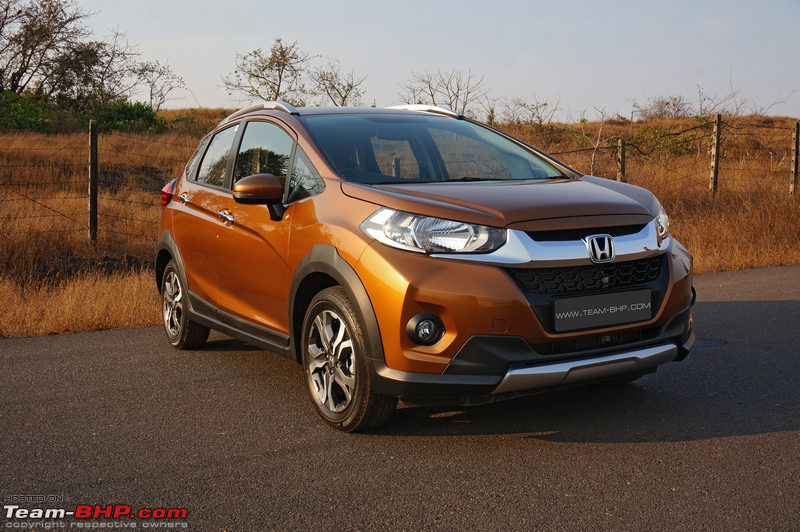 Last edited by GTO : 1st June 2017 at 16:48. |
| |  (46)
Thanks (46)
Thanks
 |
| The following 46 BHPians Thank Aditya for this useful post: | akshay81, anshumandun, ashishk29, Avikbrio, CarguyNish, carrazy, Contrapunto, darklord, Dr.AD, dZired, GTO, iliketurtles, iVento, jazzy47, Keynote, libranof1987, MDED, myavu, Nagato710, Nohonking, noopster, PGNarain, phoenixash, Ponbaarathi, Puffdamgcdragon, RavenAvi, Redline6800, roshithr, rshanker, S.MJet, samabhi, scopriobharath, Shanksta, Simhi, SmartCat, SnS_12, swiftnfurious, tc89, Thad E Ginathom, The Rationalist, uday.ere, vaasu, vb-saan, Vid6639, Vik0728, vikred |
| |
| | #2 |
| Team-BHP Support  | Review Index: Exterior Last edited by Aditya : 1st June 2017 at 15:36. |
| |  (13)
Thanks (13)
Thanks
 |
| The following 13 BHPians Thank Aditya for this useful post: | anshumandun, dZired, GTO, Keynote, phoenixash, Rajeevraj, RavenAvi, SourabhSuresh, sunny29584, uday.ere, vb-saan, Vid6639, vikred |
| | #3 |
| Team-BHP Support  | Exterior 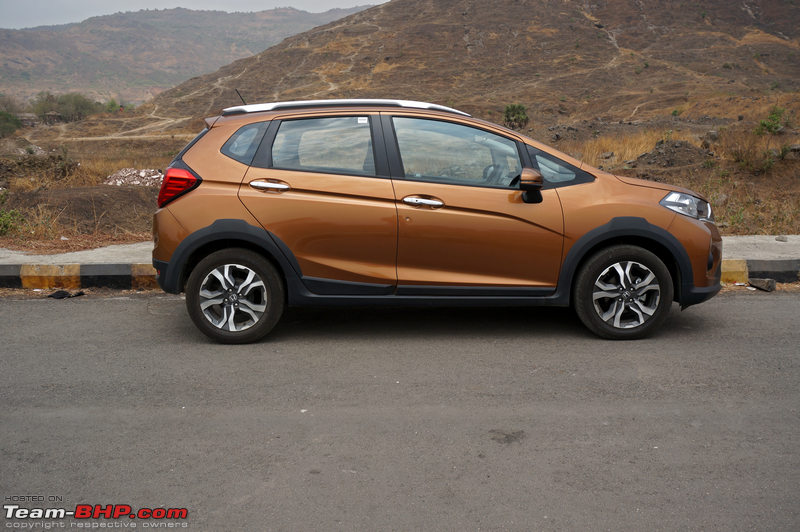 In India, cars measuring less than 4 meters in length are eligible for excise duty benefits enabling companies to price them competitively compared to larger vehicles. This has made them immensely popular among buyers. Mainstream manufacturers like Ford, Mahindra and Maruti Suzuki have also introduced SUVs that measure less than 4 meters to cash in on the benefits available with a good deal of success. Maruti's Vitara Brezza has been regularly appearing in the list of top 20 selling cars every month. Before the Vitara Brezza came along, the Ford EcoSport was a strong performer. While some manufacturers have chosen to launch separate models in the segment, others have added cosmetic enhancements to existing hatchbacks in their range to give them a crossover look. Honda launched the Mobilio-based BR-V compact SUV last year, but it's over 4 meters in length, which means the company still did not have any SUV in the sub-4 meter segment. Honda has now concocted up the WR-V to debut in this sub 4m compact SUV segment. This compact SUV shares its platform with the Jazz hatchback and City sedan. Not only does the WR-V mark Honda's entry into the sub-4 meter SUV segment, it is also an important car for the company. As we have seen in our monthly sales reports, Honda hasn't been on top of the sales charts for a while now. The City, Amaze and to a lesser extent, the Jazz are the only cars that sell in decent numbers. Recent launches like the BR-V, Mobilio and Accord stand nowhere in their segments. WR-V stands for Winsome Runabout Vehicle. This is the first model to be developed by Honda R&D India together with Honda R&D. It is built at Honda's plant in Tapukara, Rajasthan. Honda released a sketch of the car in October 2016 and unveiled the car at the Sao Paulo Motor Show the following month. While the WR-V is not as funky looking as the EcoSport or as clean as the Vitara Brezza, it is not a bad looking car and is a better effort than what Toyota and Hyundai did with the cross variants of the Liva and i20. Honda has equipped it with the usual 'urban SUV' elements, such as roof rails, black plastic cladding (along the bumpers, sides & wheel arches) and faux skid plates at the front and rear. Other than these elements, the WR-V gets more muscular bumpers, beefier wheel arches, larger wheels + wider tyres, sculpted bonnet as well as a redesigned front and rear end compared to the Jazz. All these changes go a long way in making it look more like an SUV than the MPV-ish design of the Jazz.  The WR-V measures 3,999 mm in length, 1,734 mm in width and 1,601 mm in height making it 44 mm longer, 40 mm wider and 57 mm taller than the Jazz. At 2,555 mm, its wheelbase is also longer by 25 mm and its ground clearance of 188 mm is 23 mm more than that of the Jazz. The front end of the WR-V features a sculpted bonnet which doesn't slope downwards as sharply as that of the Jazz. The wraparound headlamps are equipped with LED daytime running lights and position lights, but projector lamps are conspicuous by their absence. In between is a honeycomb mesh grille. A very thick chrome strip runs between the two headlamps and appears to merge into them. This strip really dominates the front end. The bumper has black cladding with a silver skid plate underneath. It also houses a slim and wide air-dam in the middle and a pair of foglamps with black housings at each end. On the sides, the WR-V gets flared wheel arches lending it a muscular look. The character lines from the Jazz have been carried over and with the redesigned front bumper and fender, the car gets some more creases. Overall, we feel that there are more cuts & creases here than we would have liked. There are the black plastic claddings on the wheel arches, running boards and doors and silver & black roof rails. The doors, ORVMs with integrated turn indicators and window glasses are shared with the Jazz. The WR-V runs on smart looking 16-inch alloy wheels which have a silver & black finish. While the wheels appear proportionate to the height of the car, those 195 mm tyres should have been wider. Both - the EcoSport and Vitara Brezza get fatter rubber. The rear of the car is distinguished from the Jazz by a redesigned tail-gate, smaller roof-mounted spoiler and beefier bumper. The tail lamps have also been redesigned and appear to stick out from the sides a lot more than those of the Jazz. The larger chrome strip seen just below the rear windshield of the Jazz has been left out while the number plate is housed low on the tail-gate and has a thick chrome garnish above it. The lower portion of the bumper features a black cladding and like the front, there is a faux skid plate. There are reflectors at both ends of the bumper as well. Panel gaps are even for the most part, getting wider around the bonnet and tail-gate. The paint quality and exterior fit & finish on the other hand are good. Overall, the car feels well screwed together. The build quality feels light and the doors shut with a clunk rather than a solid European thud. The bonnet is very light as well. There is no EcoSport level of sturdiness here - the sheet metal is thin and there is a good deal of flex on the metal if you push any panel with your thumb. Under the skin, a high-tensile steel frame has been added in the middle of the body to enhance collision force absorption and the rigidity of front pillar, lower front & rear suspension mounting areas and rear pillars has been increased by the addition of new parts. Coming to safety, the WR-V gets two airbags and ABS + EBD standard across all variants. Honda has also equipped the car with intelligent pedals, which is essentially a brake override system. In case the driver accidently presses the brake and accelerator pedals together, the ECU will intelligently override the accelerator signal and apply the brake (sorry heel and toe lovers, this Honda ain't for you). The front face adopts more horizontal and aggressive lines compared to the Jazz. Even then, the WR-V doesn’t have the street presence of the Ecosport or Brezza: 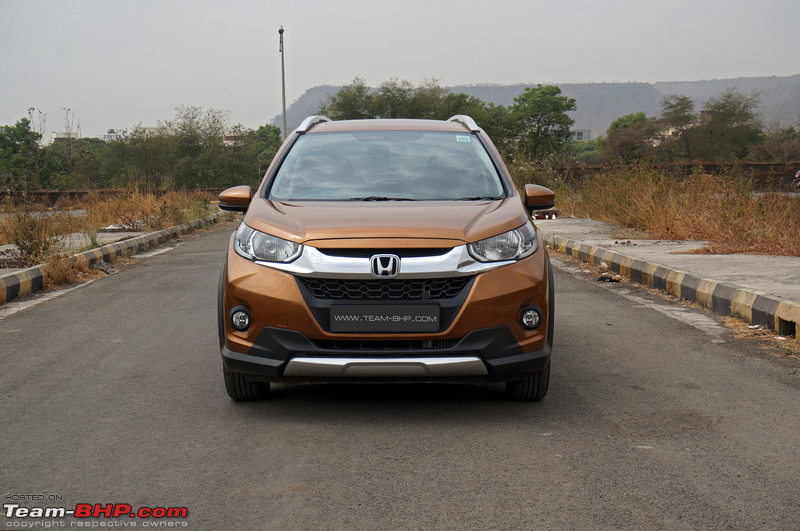 Similarities with the Jazz are apparent from the rear. A tail-mounted spare (à la EcoSport) would've greatly enhanced its SUV credentials. Thankfully use of chrome is limited to just the number plate garnish: 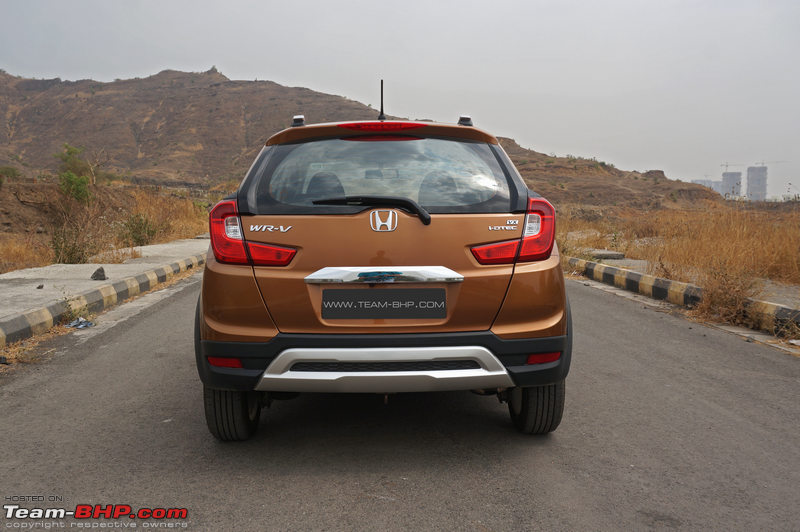 A flatter bonnet, side body cladding, raised suspension with larger wheels and roof rails make the WR-V appear much more like an SUV compared to the MPV-ish Jazz on which it is based. The WR-V’s design is not as clean as that of the Vitara Brezza due to the excessive cuts and creases in the design: 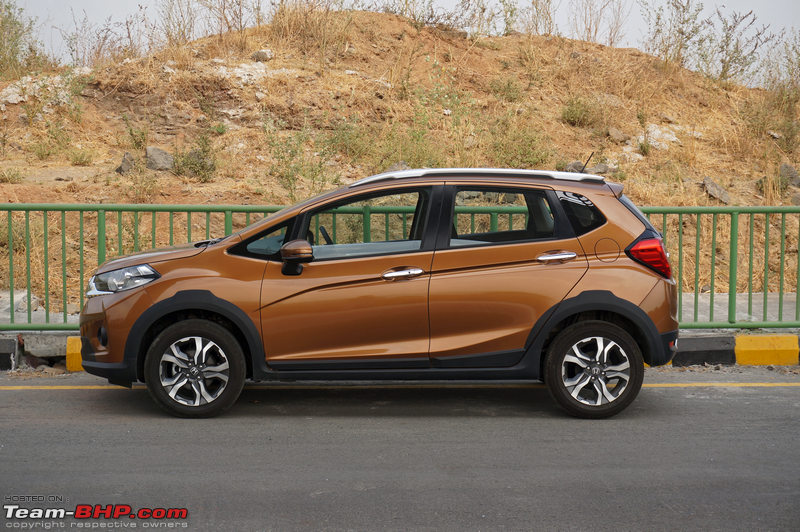 Flared wheel arches lend the WR-V a muscular look. At 2,555 mm, the wheelbase is longest among its rivals: 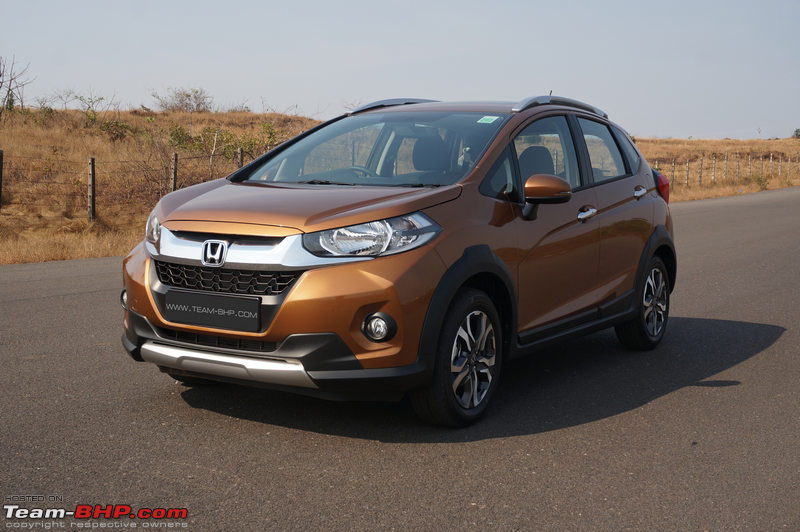 The generous ground clearance & plastic cladding help in trying to make it look like an SUV, but there is no getting away from the fact that this is just another hatchback posing as an off-roader: 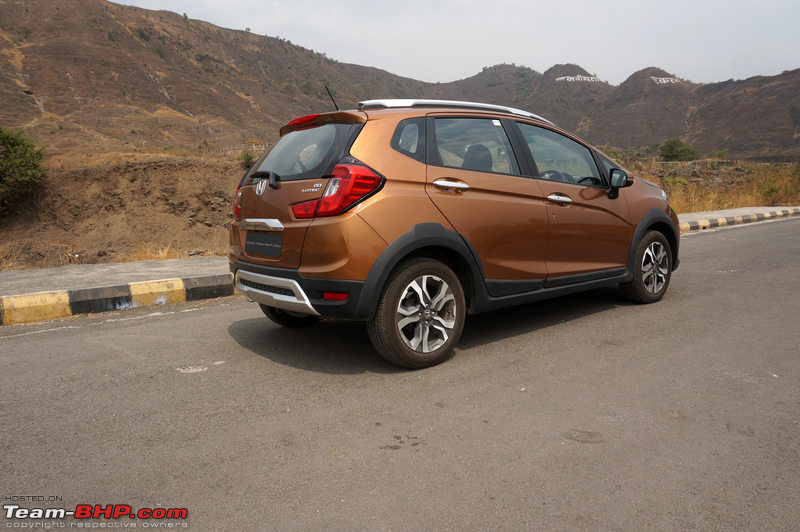 Headlamp cluster gets traditional halogen lights in a reflector along with the L-shaped LED daytime running lights (DRLs), position lights and turn-indicators. Projector lamps should have been provided considering the Vitara Brezza gets them:  Black plastic strip splits the turn-indicators and position lights: 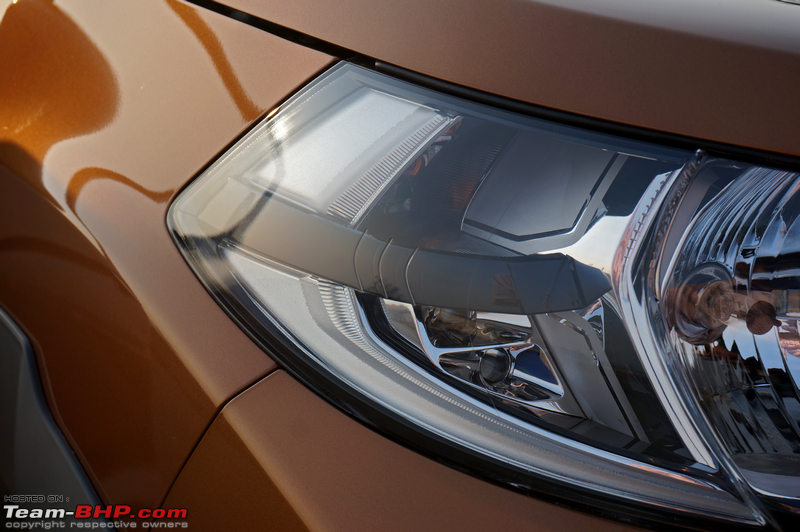 With all the lights in action: 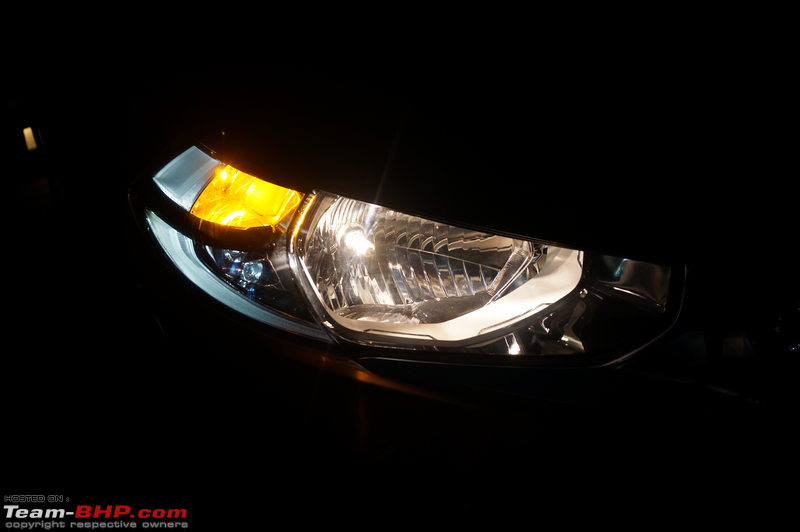 L-shaped LED DRLs and position lamps are on by default. They are not as prominent as those on some other cars. Switching on the pilot lamps make them dim a little: 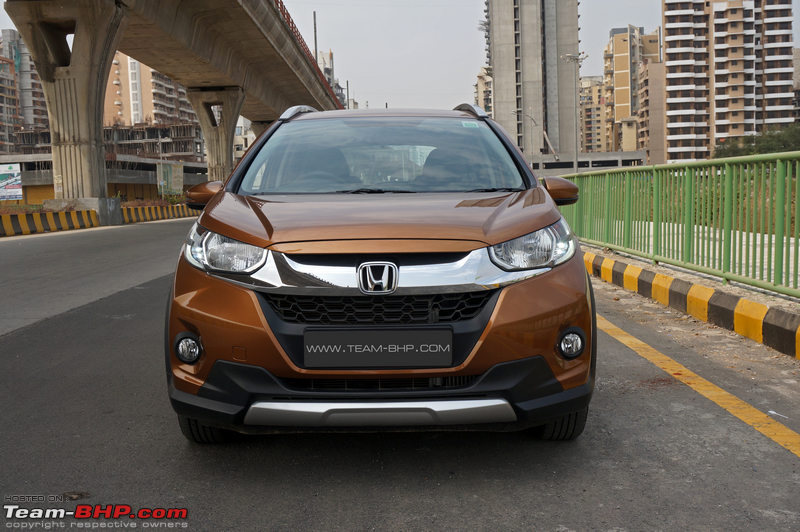 Very thick chrome garnish is different from the ones seen on other Hondas and extends below the headlamps. Most enthusiasts will find this chrome treatment to be excessive. Grille is V- shaped and gets a honeycomb mesh treatment: 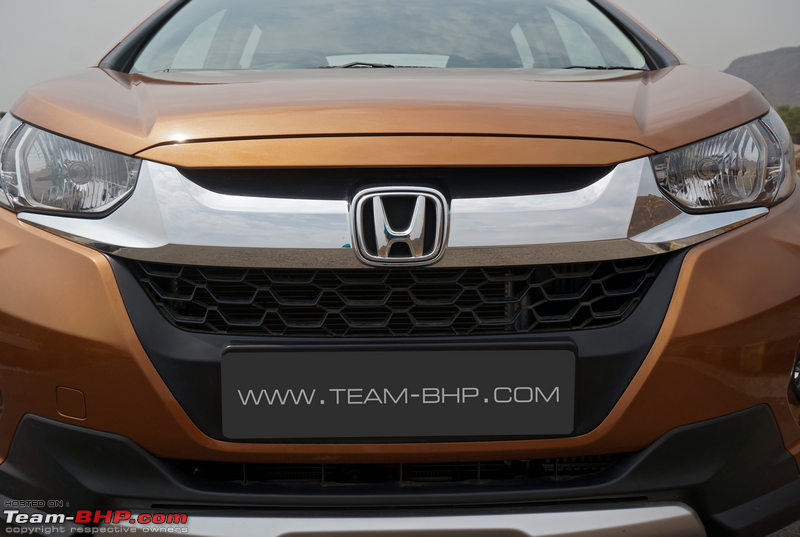 Front bumper is a lot more edgy than the Jazz’s with more cuts and creases. Its lower portion is blackened and has a silver faux skid plate: 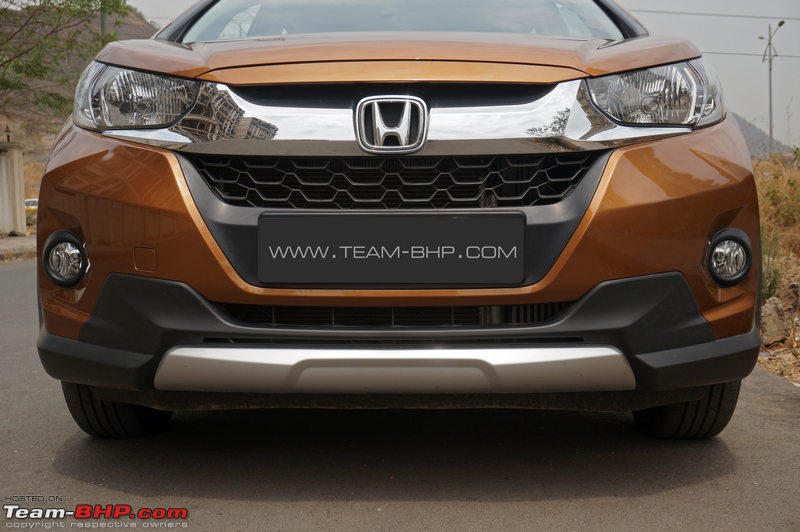 Number plate is housed on thick black plastic below the grille. Air-dam consists of a couple of thin horizontal slots. Notice the vertically mounted intercooler next to the air-con condenser:  Small, round foglamps have black surrounds and are positioned close to the corners: 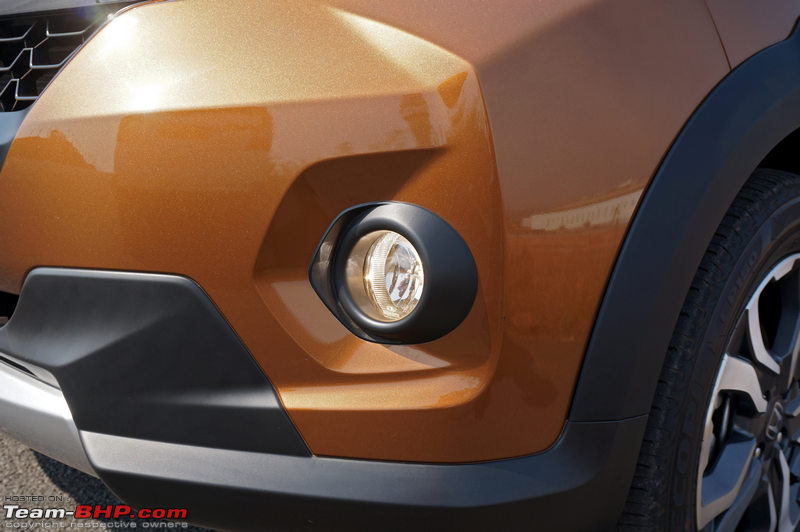 Diesel gets a healthy amount of underbody protection at the front. A wind deflector has been provided as well: 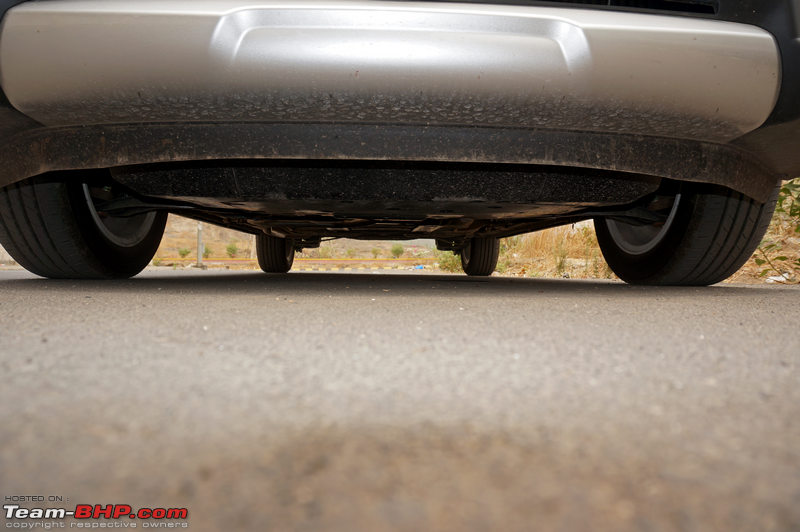 Clamshell bonnet is different from the Jazz's. It's a little too short for the length of the car:  Windshield washers are neatly concealed under the bonnet. They squirt out effective sprays (rather than jets) of water.:  Panel gaps are small for the most part, but they aren't perfect. The bonnet on a few of the cars had a bigger shut line than expected. Look closely and you'll be able to see parts of the engine bay through them: 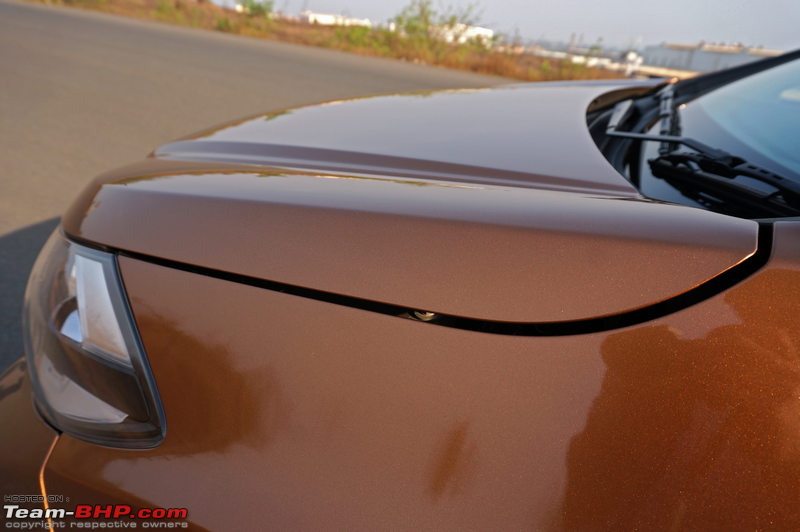 Front bumper sticks out very slightly - much like most cars on sale today: 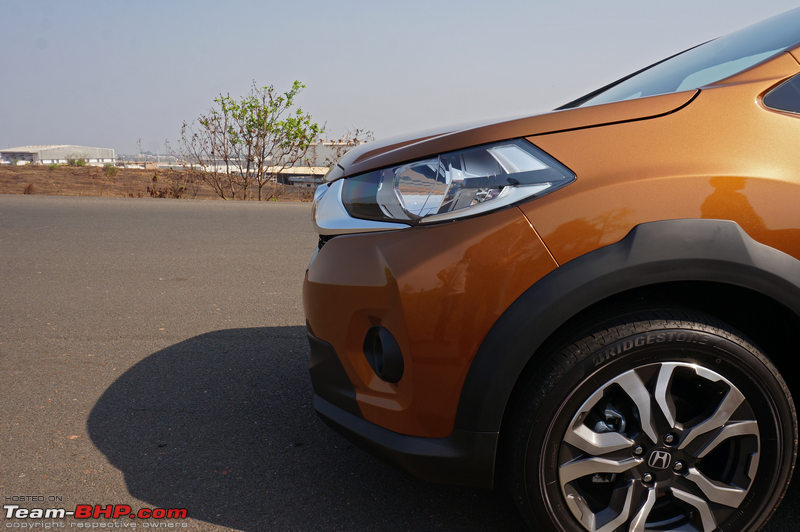 Front wheel wells get partial cladding:  Ugh, no wheel well cladding at the rear: 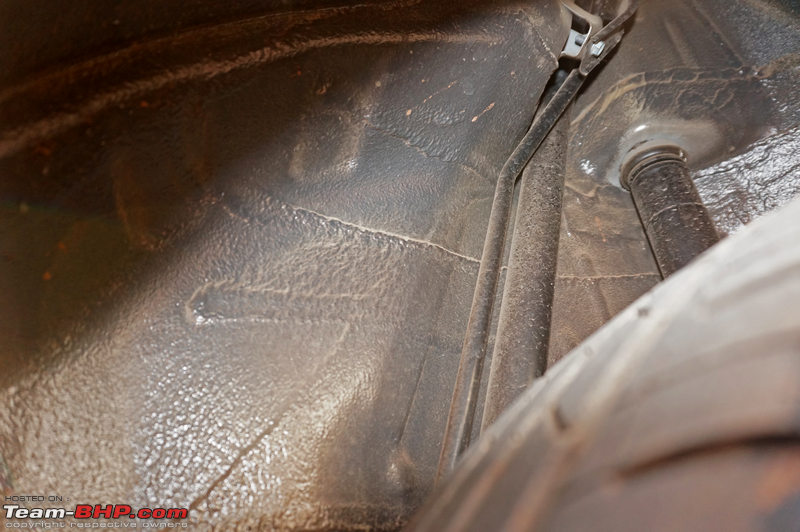 Electrically-foldable ORVMs with integrated turn indicators are shared with the Jazz and City: 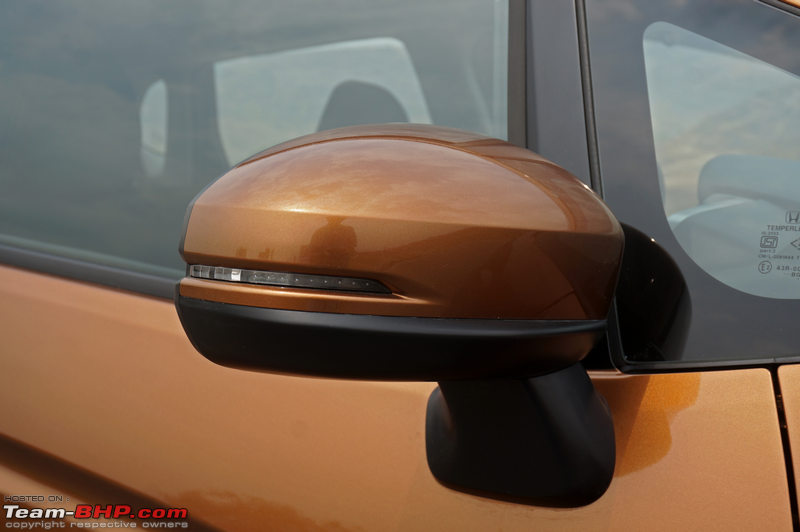 Grab-type chrome door handles feel solid. Both front doors get request sensor. Driver’s door gets keyhole that looks lost on the door. Should have been integrated with the door handle:  16-inch black & silver alloy wheels look smart. They fill the wheel arches nicely, but the 195 mm tyres should have been wider:  Wheel arches are flared for character & further enhanced by the black plastic cladding: 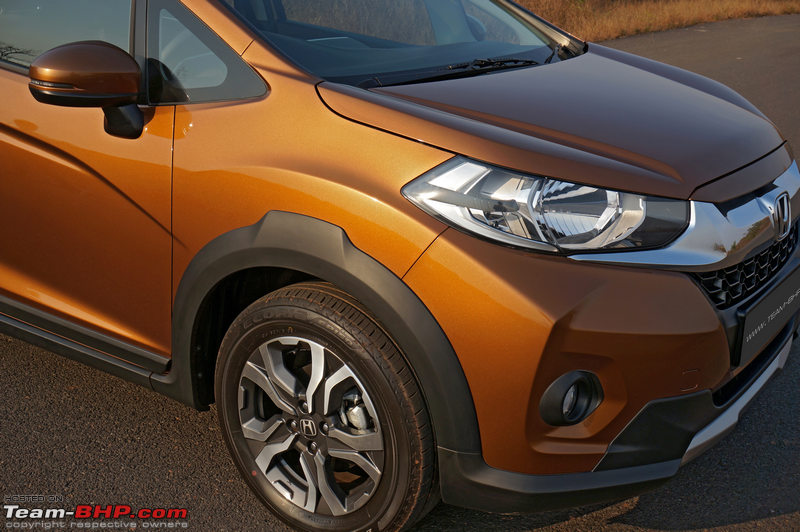 Plastic cladding runs across the car. Check out the prominent crease on doors carried over from the Jazz: 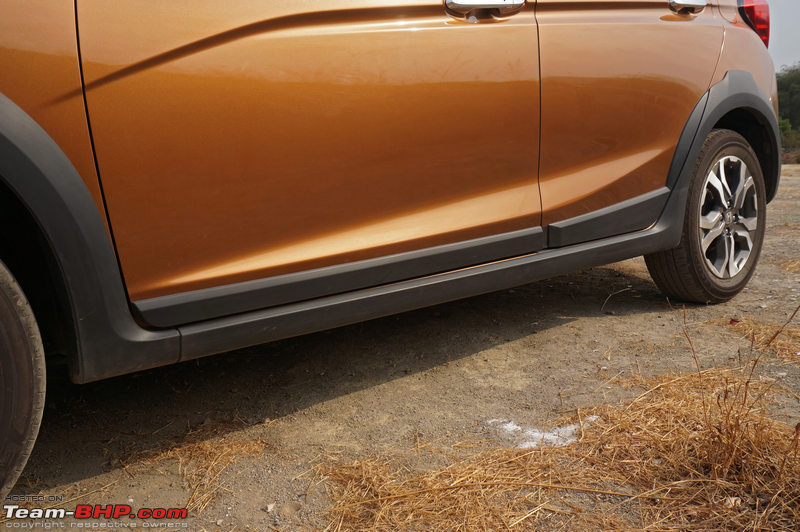 Blackened window panes & B-Pillar. Roofline tapers towards the rear, but overall glass area is large with quarter glasses at both ends: 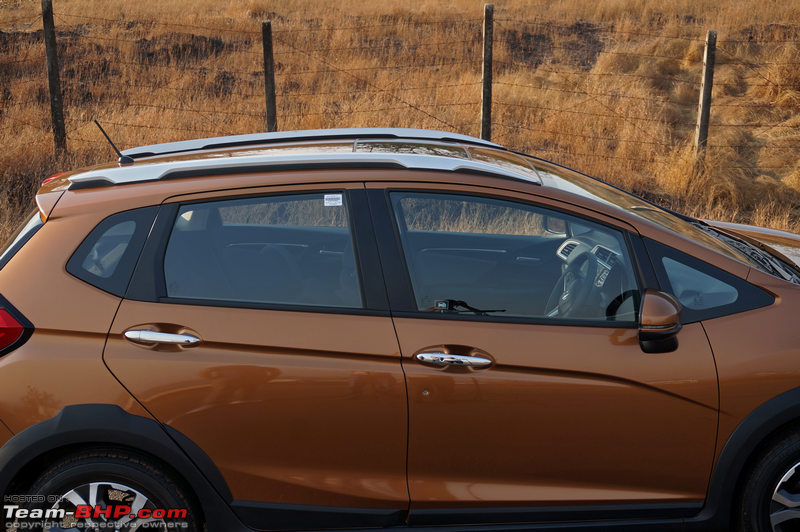 Strong ridge / belt-line running across the side and flowing into the tail lights is a typical Honda design trait. Looks sharp: 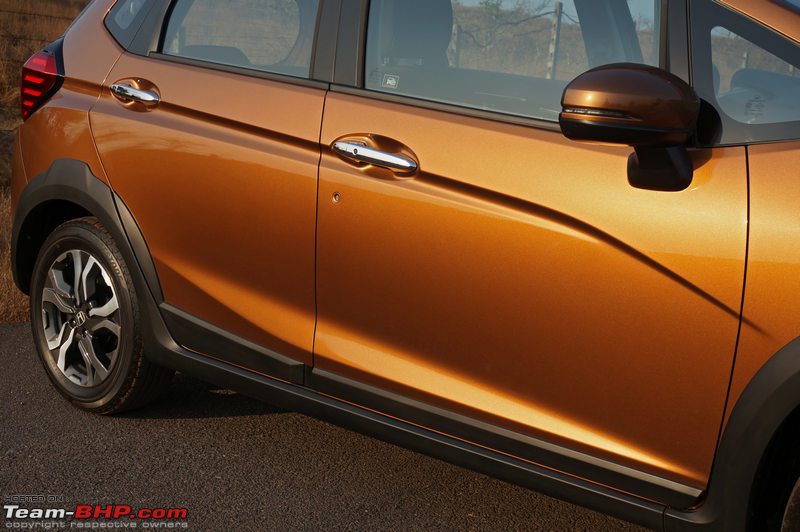 Notice how the cladding has been applied on the rear door to make it merge with the cladding on the wheel arch. Looks well finished: 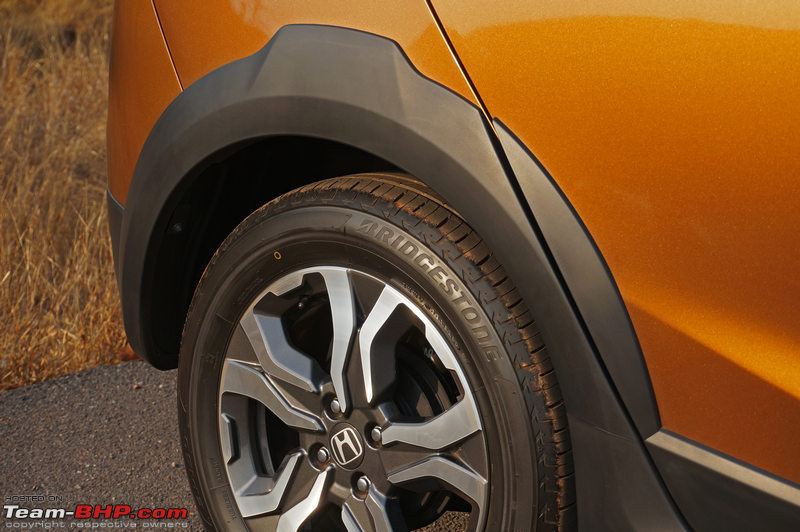 Large silver & black roof rails feel firmly attached and enhance that SUV-look. Roof doesn't get a ribbed pattern: 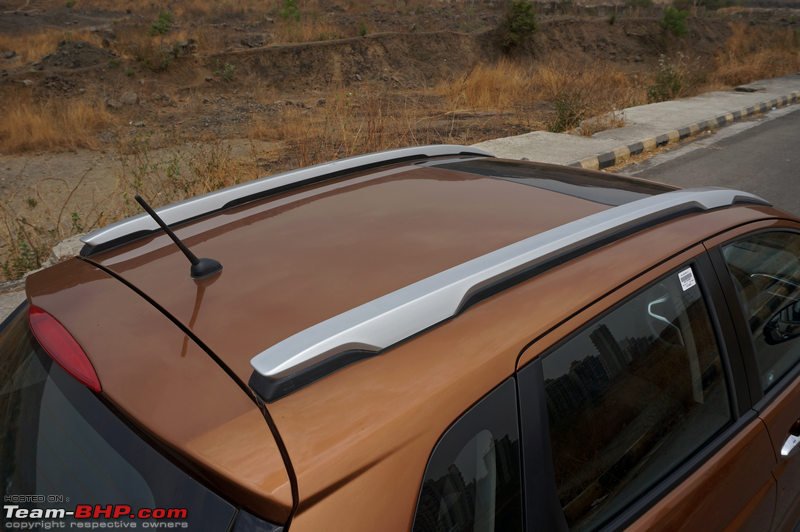 The VX variants gets a very-welcome sunroof: 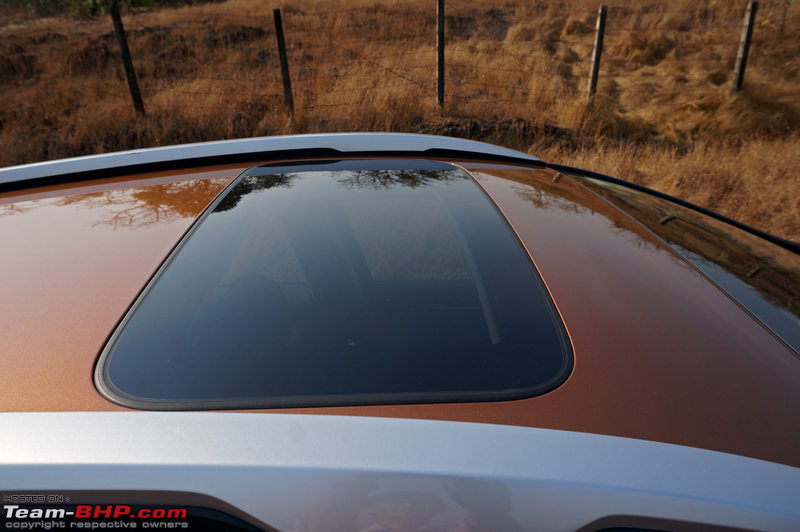 Tail-gate gets a neatly integrated spoiler, which houses an LED HMSL: 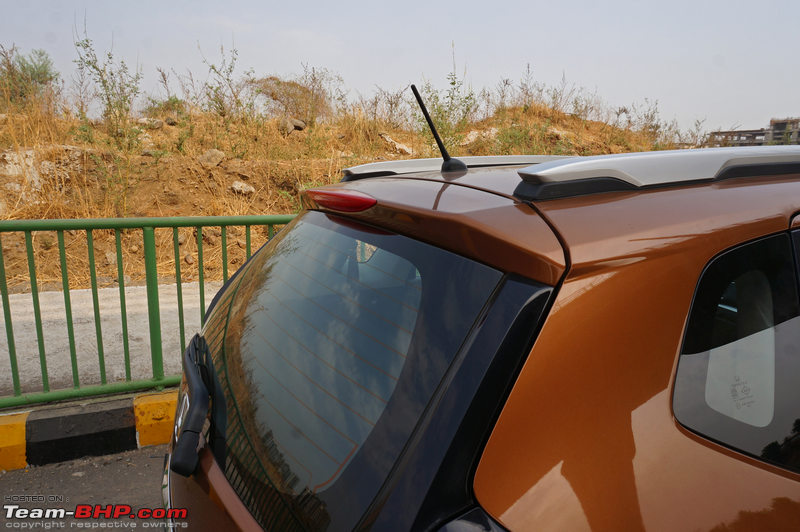 Rear washer is neatly integrated into the HMSL console: 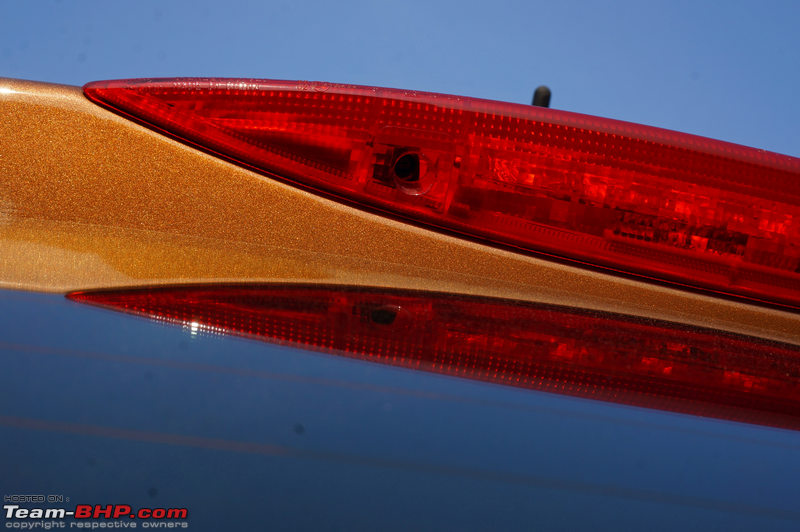 Stubby radio antenna mounted towards the rear: 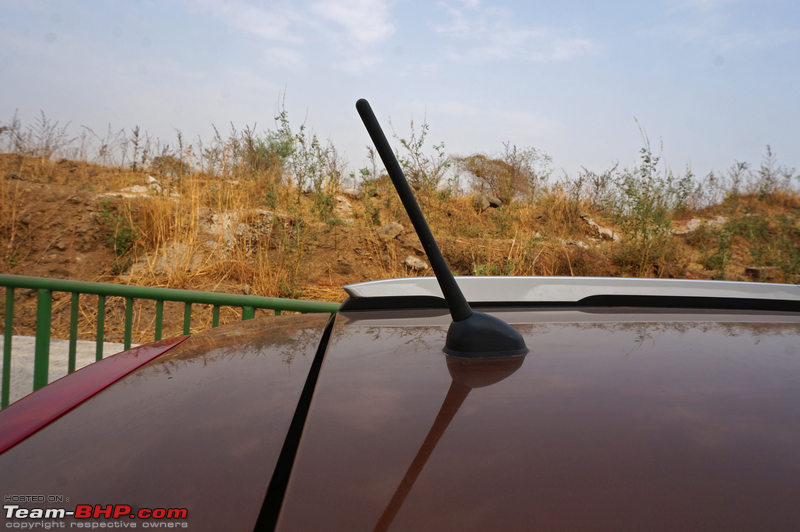 Rear bumper doesn't protrude out. For namesake only? A rear impact will easily dent the hatch: 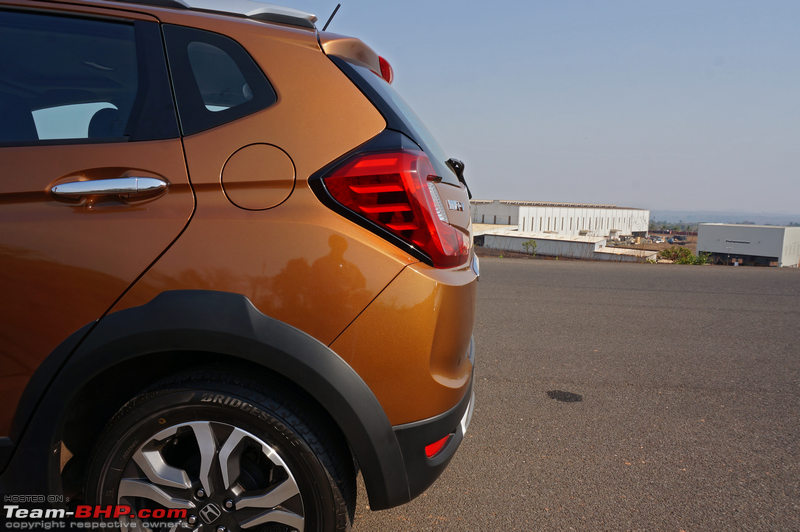 Tail-light clusters are now split and extend to the tailgate. Bulbs are halogen units: 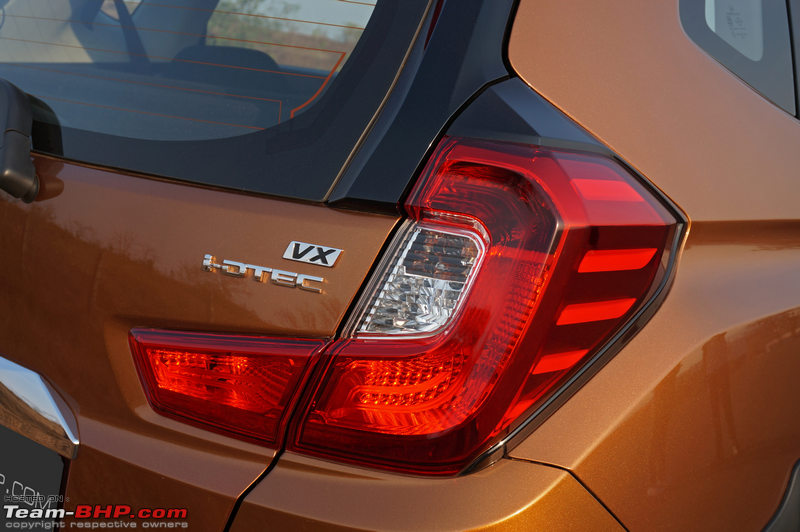 A closer look at the detailing on the sides of the tail-lights: 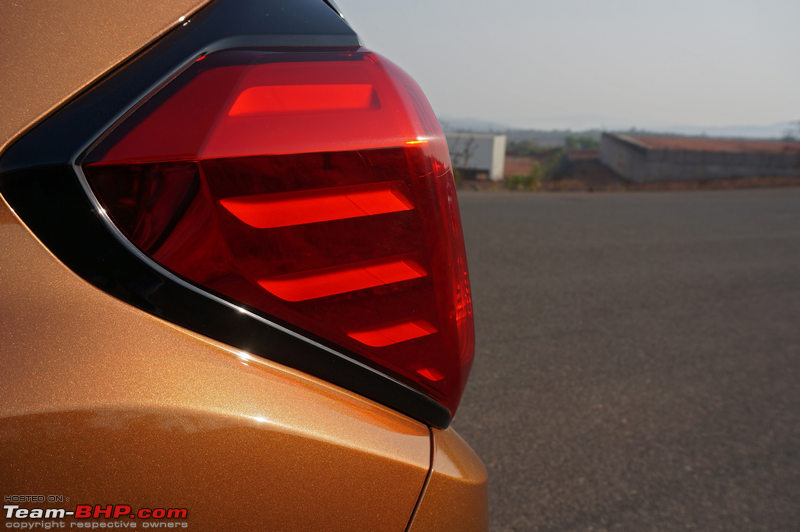 Here’s a look at how the tail-lamps jut out. Notice the black insert on the top: 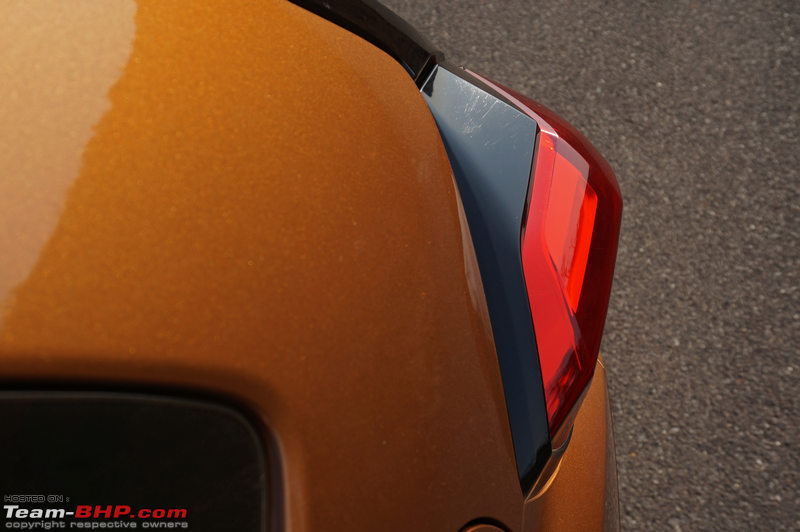 With all the lights in action. Brake lights are located right on the top, while turn-indicators and reversing lamps are situated on the inside: 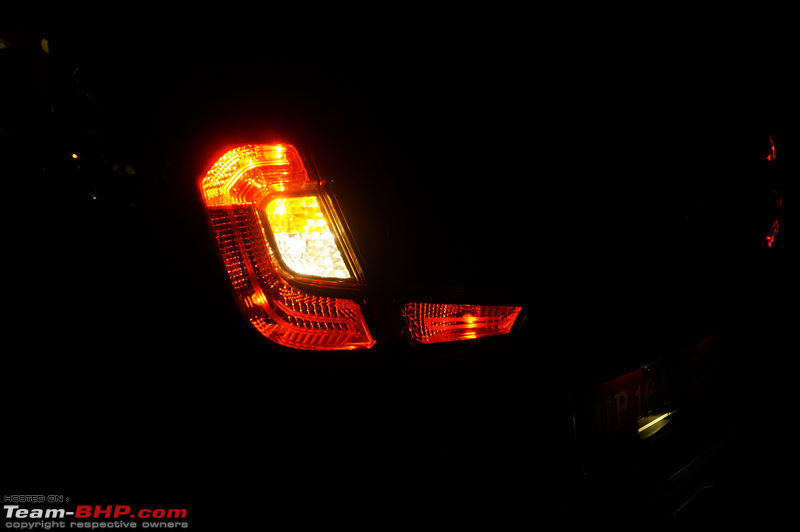 Glossy black plastic candlestick tail light extensions replace the reflector units seen on the Jazz: 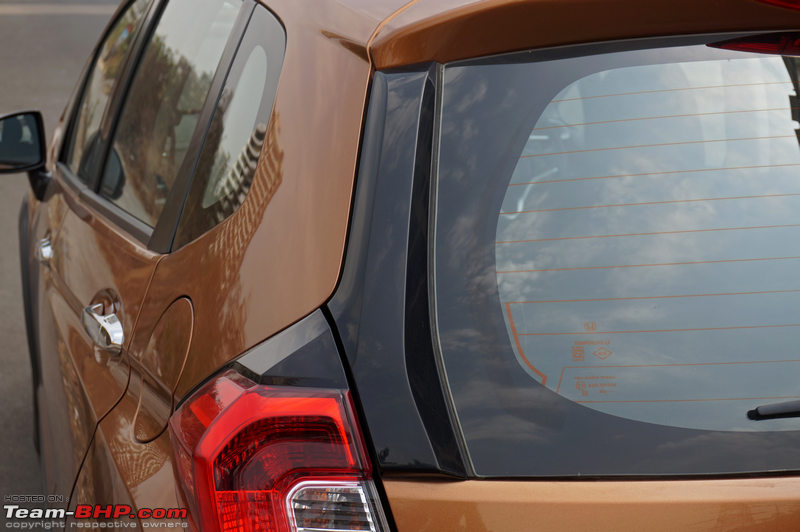 Rear windshield is identical to the Jazz’s. However, the tail-gate has been redesigned and the H badge sits just below the windshield. Thankfully, the large and hideous chrome strip found on the Jazz has been dropped: 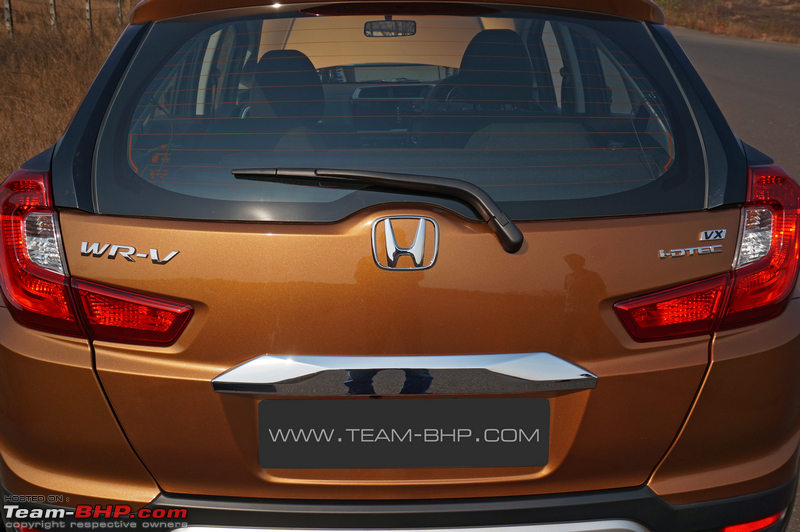 Rear bumper also gets a faux skid plate. There are reflectors on both sides, but no rear foglamps or reverse parking sensors. Parking aids are commonplace today - they will surely be missed by owners: 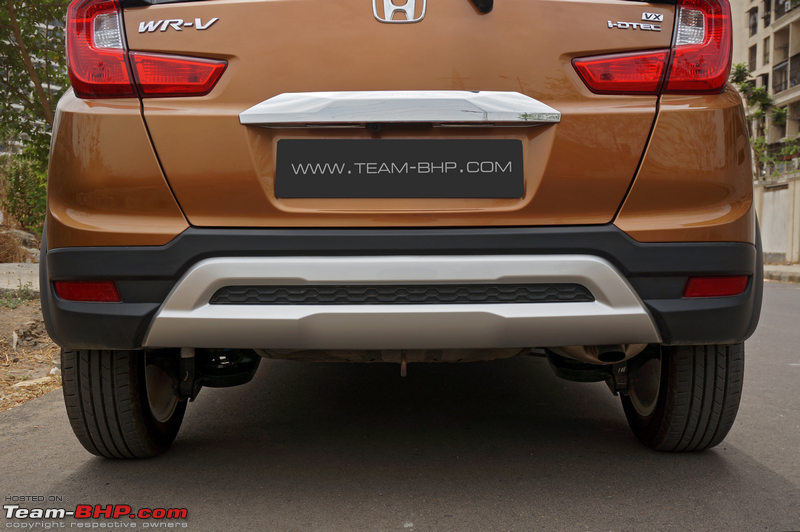 Reversing camera neatly tucked under the chrome garnish: 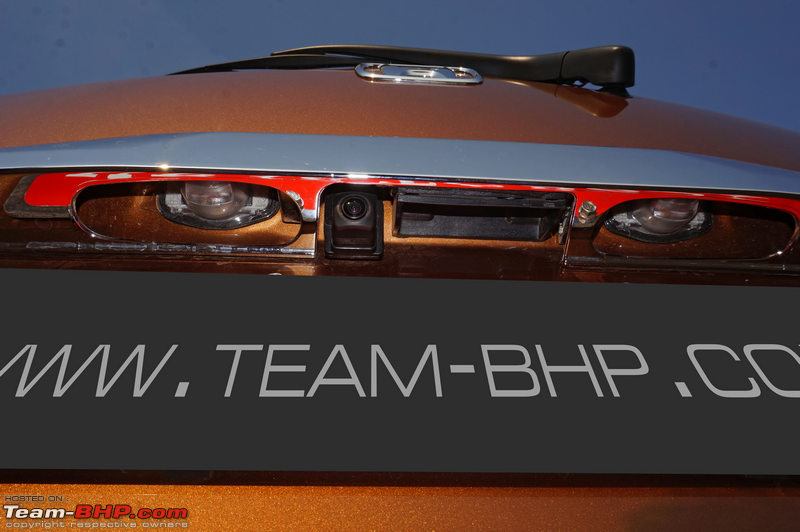 Unlike the Jazz, a chrome badge of the model name is placed on the left of the hatch: 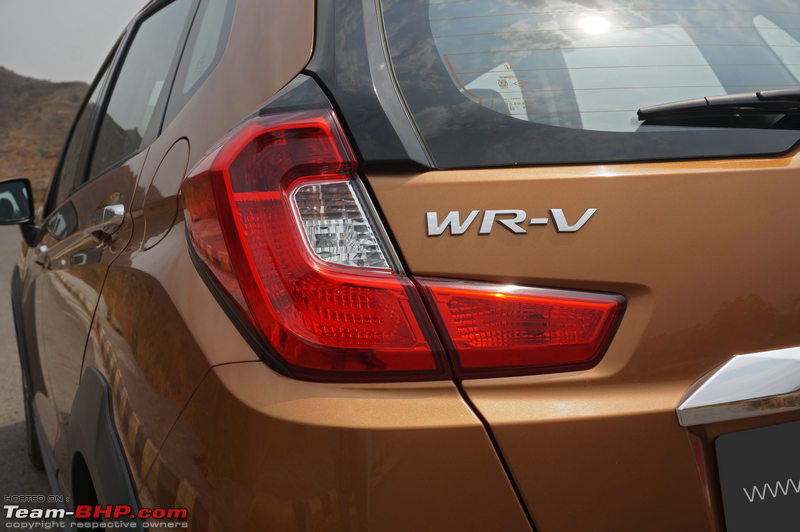 Badges denoting variant and engine are located on the right. You'll only see the i-DTEC badge in India, as WR-V diesel isn't offered anywhere else in the world. Period:  Swoopy, chunky rear wiper: 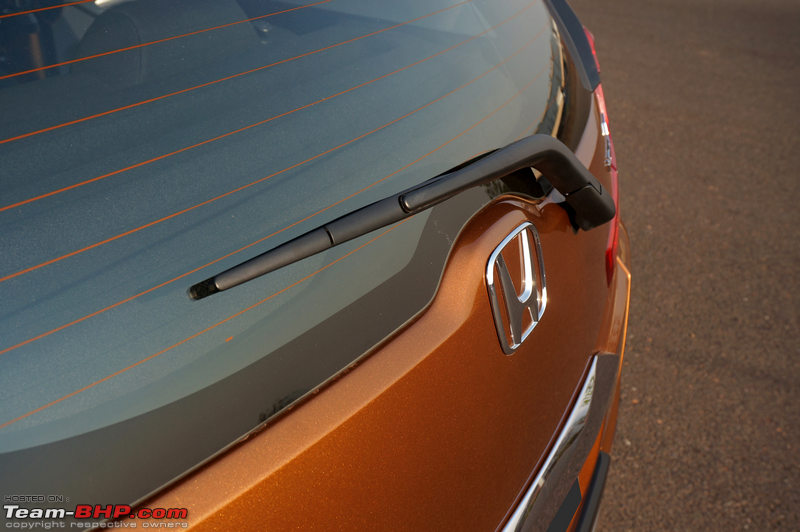 Fake skid plate has contours and a fake mesh grille:  A closer look at the reflector. Shockingly, no rear foglamp! At this price point, I would have expected one. The EcoSport gets one: 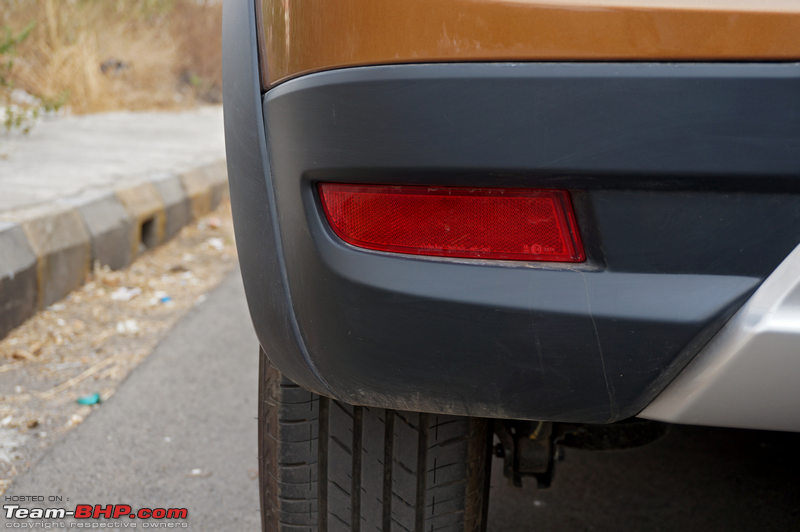 188 mm of ground clearance is lesser than rivals, but enough to help you clear most obstacles on the road. Rear suspension is a twisted torsion beam setup. Tow hook located in the center, while the tail pipe is on the right: 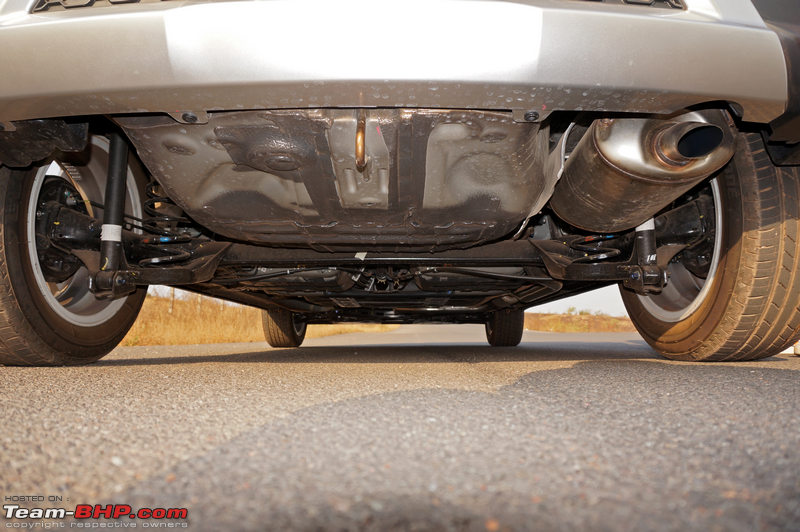 Last edited by Aditya : 31st August 2017 at 12:02. |
| |  (32)
Thanks (32)
Thanks
 |
| The following 32 BHPians Thank Aditya for this useful post: | aabhimanyu04, anshumandun, arjab, Avikbrio, carrazy, Dr.AD, dZired, GTO, gupta_chd, InControl, Karthik Chandra, libranof1987, Nohonking, phoenixash, procrj, RavenAvi, Redline6800, rshanker, S.MJet, samaspire, sarathlal, scopriobharath, shipnil, Simhi, SmartCat, sunny29584, swiftnfurious, uday.ere, Varun_HexaGuy, vb-saan, Vid6639, vikred |
| | #4 |
| Team-BHP Support  | Interior - Front  The front doors of the WR-V open in a three step action and the height of the WR-V makes ingress / egress very easy. Once inside the WR-V, you are greeted by a familiar looking dashboard & steering wheel. To the average Joe, the interior would look identical to that of the Jazz. It is only when you look closely that you notice subtle differences. While the all-black interior theme and design of the dashboard is carried over from the Jazz, an additional silver insert is added on the passenger side. Fit and finish are decent for the most part, although some of the plastics are of the hard and scratchy variety. Unless you're a real stickler for quality, there isn't much to fault. No, you won't find apparent signs of cost cutting. The headlight / wiper stalks are nice to use and have a damped quality to them. The lower half of the interior does suffer from average quality bits though. Some of the plastics in the footwell area are merely budget-grade. The handbrake for example is made of hard plastic rather than soft rubber like feel. What dilutes the premium feel are the numerous dummy switches in the cockpit. For instance, in the petrol, there is a round plastic cap that plugs the spot where the engine start button is supposed to be! Only the diesel WR-V gets this feature! The Ford EcoSport is still the benchmark for sub-4 meter SUVs as far as quality & finesse are concerned. It feels more premium than the WR-V. The diesel WR-V is equipped with a smartkey-based keyless entry & go system. Simply press the request sensor on the chrome door handle (with the smartkey in range) and enter the car. It can also be unlocked by pressing a button on the key fob. The locking / unlocking action is quite silent (not clunky as in some other cars). Wonder why Honda have omitted this for the petrol? Once you get in, you'll notice the incredibly massive glass house. The large windscreen, huge windows and front quarter-glass give this cabin an airy feel, in spite of the interiors being all-black. The sunroof further helps brighten up the cabin. I found the driver and passenger seats to be wide and fairly supportive. The seats are chunky unlike the ultra slim ones like in the BR-V and the fabric upholstery quality is pretty nice. The seats are easily more comfortable than the narrow ones in the Ecosport or the short squab seats of the Brezza. The doorpads get some of that fabric material too. Space up front was never going to be a problem with the WR-V. Its cabin feels wider than most cars in the class. Legroom is more than you'd ever need, and it's the same story with the headroom as well. While lateral visibility is fantastic, frontal visibility can be a pain around a junction / corner due to the fat A-pillars & quarter glass design. This creates serious blind spots. The ORVMs are big and give you a good view of the action behind. However, while the IRVM shows you as much as it can, the rear pillars seriously hamper visibility. You'll have to be cautious when reversing into your parking slot. Thankfully, a reversing camera has been provided. The ergonomics are perfect and everything falls into place easily. This is a very user-friendly car. The steering wheel is similar to the hatchback's, but isn't wrapped in leather and has more buttons for the telephone and cruise control functions. It also gets rake and reach adjustments. The driver's seat height adjustment range can go to extents you wouldn't believe! It'll easily accommodate the shortest & tallest of drivers. Unlike the Jazz, the WR-V gets a driver armrest. However, it is thin and weirdly shaped making it inconvenient to use. The instrument cluster is again, shared with the Jazz. It has three dials - a tachometer on the left, a speedometer in the center and an MID on the right. The dials are clear and easy to read on the move. The MID has a real-time fuel efficiency meter as well. FE fans will love how the graphical bar moves with a light foot. Like its sedan counterpart, the WR-V has ambient cluster lights that glow green if driven sensibly (blue colour when you don't). You get an average FE display and a distance-to-empty readout too. Like all Hondas, the instrument cluster remains illuminated at all times. The center fascia too has been carried over from the Jazz. The feather-touch air con controls are nice to use once you get the hang of it. Though you will need to take your eyes off the road to change climate control settings though. The air-con's cooling capability is excellent. The piano-black panel around the ICE is tasteful, though there are reflections under sunlight. It's a big fingerprint magnet as well. The VX variant gets a 7-inch touchscreen head-unit equipped with Bluetooth, USB and Aux, along with steering mounted controls. The Bluetooth system won't allow you to pair your phone while driving. Some other features of the system include 1.5 GB of internal storage, dual Micro SD card compatibility, navigation, HDMI and MirrorLink connectivity. The ICE doubles up as a display for the reversing camera. You get 3 viewing options (Normal, Wide and Top) and the parking display shows static guidelines. Practicality is one of the WR-V's stronger points and we found many conveniently placed storage spots. There are numerous cup / bottle holders all round the cabin. Each door gets a bottle holder that can hold a 1L bottle. The door pockets are usable when they're not carrying bottles. Place a Bisleri and there's just a little space left for anything else. The driver's air-con vent has a can / bottle holder right in front of it to keep your soda can cold. The size of the glovebox is standard fare, nothing impressive. Ahead of the gear lever are two cupholders and a big storage bin that can take a smartphone lying flat. Then, to the right of the handbrake are two cubby holes, one deep and the other shallow. Behind the handbrake and under the armrest is one more storage compartment. The water bottle holder on the center console, which is present in the Jazz has disappeared. Dashboard design is identical to the one in the Jazz. It has an all-black theme with silver and piano black inserts. Plastics used are hard and scratchy:  Windscreen is huge and offers a good view of the road ahead. However, even though the WR-V is higher than hatchbacks and marketed as an SUV / crossover, the view is not commanding like a proper SUV. Shorter folk will not be able to see any portion of the bonnet from behind the wheel unless they raise the seat up high:  The dash design lacks symmetry and looks quite busy. Enormous glass area makes even this black cabin feel airy:  Steering wheel is chunky to hold. However, it's missing leather wrapping and thumb contours:  Basic audio controls on the left spoke. Large buttons are easy to operate. No mute button provided:  Buttons for operating the cruise control are located on the right spoke. To engage the function, press the cruise control button. A "cruise main" indicator lights up in the instrument cluster. Then long-press the set button and a "cruise control" indicator comes on in the instrument cluster. Then you can increase or decrease speed according to your liking. To disengage the function, use the cancel button or simply tap the brakes: 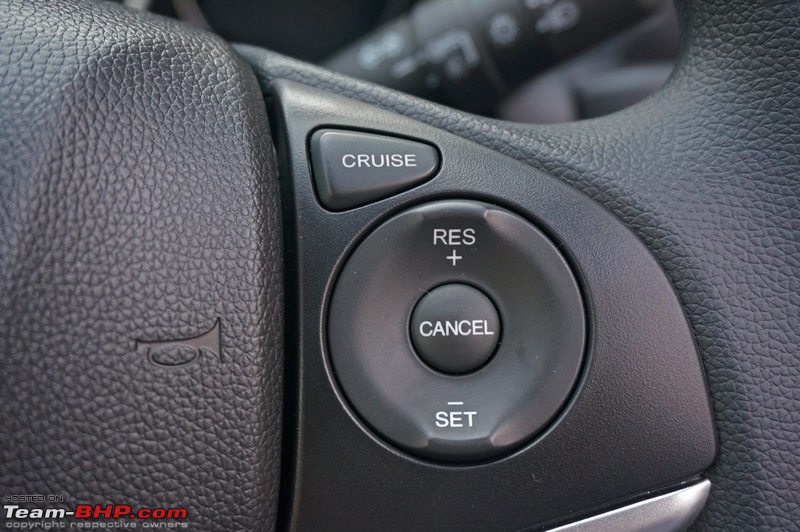 Telephony controls located behind the steering wheel. You have to pull the buttons towards you to operate. VX variant gets a button for voice commands too. The rear of these buttons have a recessed area for your fingers:  The steering offers tilt & telescopic adjustment. Both have a satisfactory range. It didn't take me any time to set it to my liking:  Instrument cluster is shared with the Jazz. It has three dials - a tachometer on the left, a speedometer in the center and an MID on the right. The dials are clear and easy to read on the move. If the seat-belt is not buckled, the warning light flashes 6 times along with a warning sound. After this, the light remains on but the sound stops. Diesel redlines at 4,000 rpm…  …while the petrol version redlines at 6,400 rpm:  To toggle through the MID, you need to use the spindly stalk that's located at the top right of the instrument cluster. Not cool. A steering / stalk mounted button would be preferred:  MID has a clock, distance-to-empty counter, 12/24 hour clock, outside temperature, odometer and two trip meters: 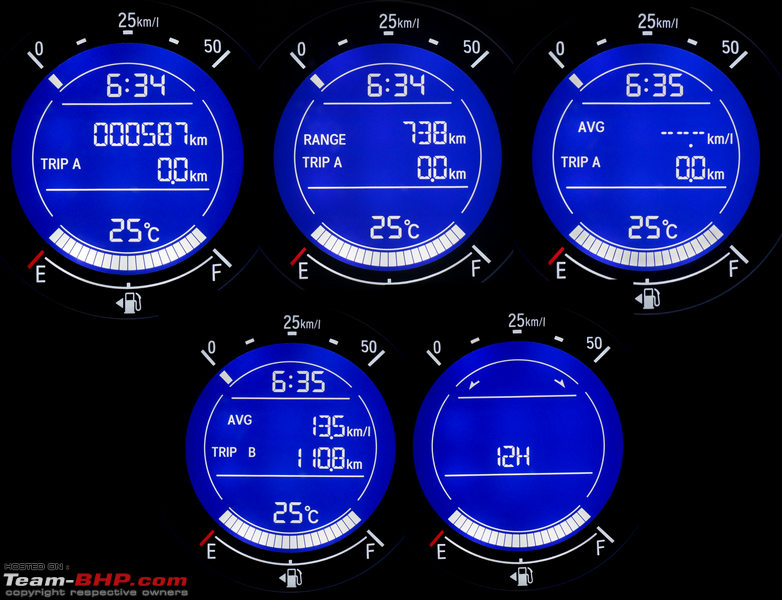 The graphical bar on top indicates real-time fuel efficiency, while the bottom bar displays the fuel level:  Chunky stalks are taken from the Jazz and are standard Honda fare. They feel durable:  Diesel's gets a shiny engine start/stop button which is lifted from the City facelift. The button is usually without any back light colour. Press the clutch and it gets backlit in white. Press the clutch and hit the button and it lights up in red as the engine starts and runs:  Egad! A dummy cap in the WR-V petrol that will always remind you what Honda didn't give you. No variant of the petrol comes with an engine start / stop button:  Side air-con vents get a dial to shut the air flow completely. Only the lower vent is functional. The vent on the top is a dummy:  Useful cupholder to park that Coke can in front of the cold air vent. The cupholder is adjustable for larger bottles as well. Neat! 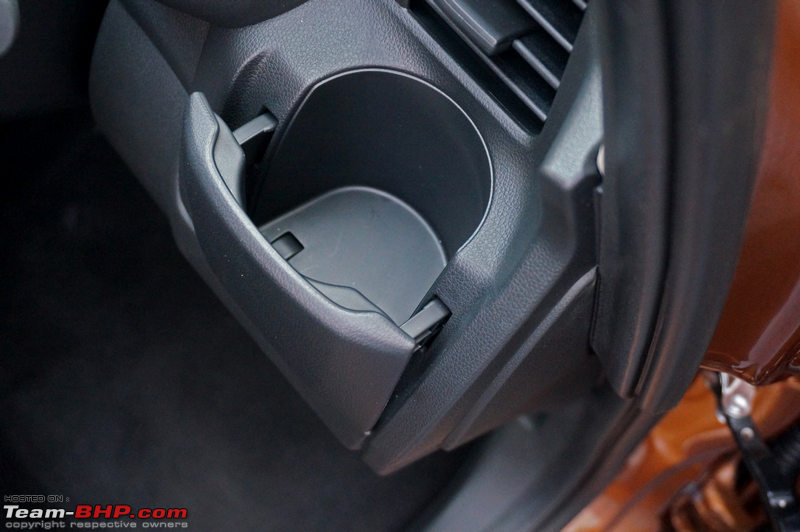 Headlight leveller sits to the right of the steering, below the cupholder. It looks like it's from a Maruti 800! 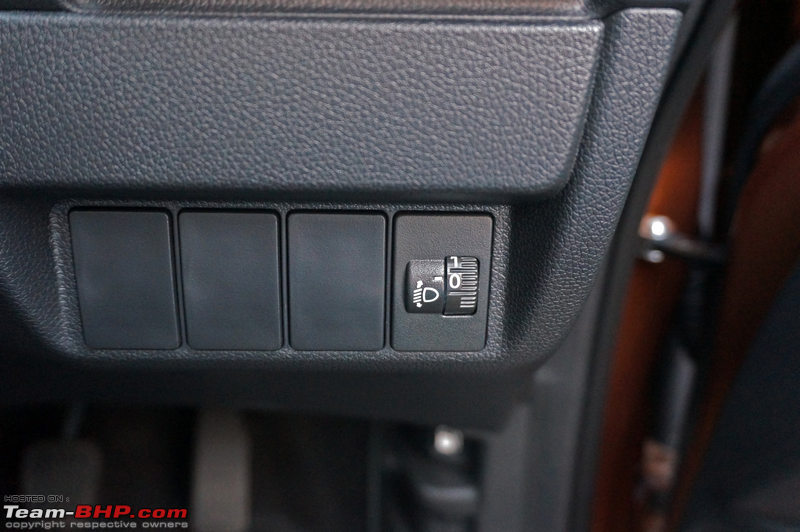 Bonnet & fuel lid release levers placed near the drivers footwell below the dash:  Doorpads are the same as the Jazz. Like the City, they flex when the window is lowered or rolled up:  Silver door handle is carried over from the Jazz. It feels robust and durable. No speed sensitive auto-locking system provided: 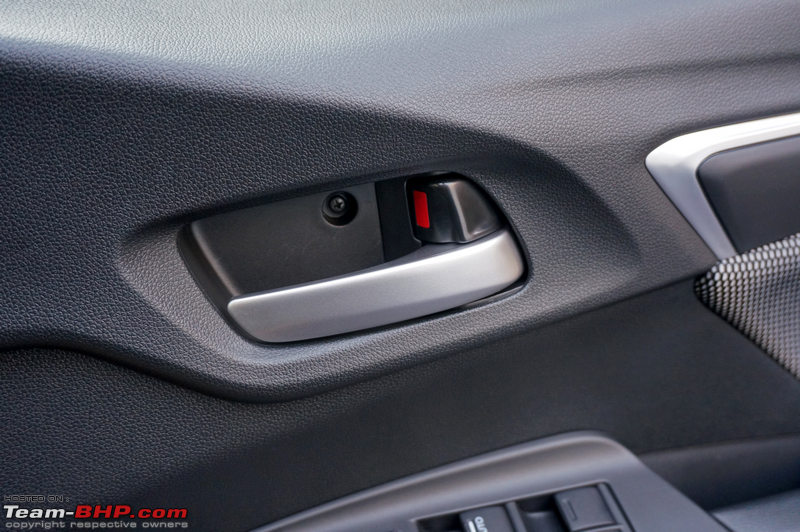 Standard switchgear for the power windows, central locking system and ORVMs. Yup, the ORVMs are electrically foldable. Only the driver's window gets the auto up / down and anti-pinch feature:  The silver strip and cloth padding lend a premium touch to the doorpad. Sadly, the base where you rest your elbow isn't padded:  Doorpad can hold a 1-liter bottle, and other small items:  Interesting rubber beading around the door locking mechanism: 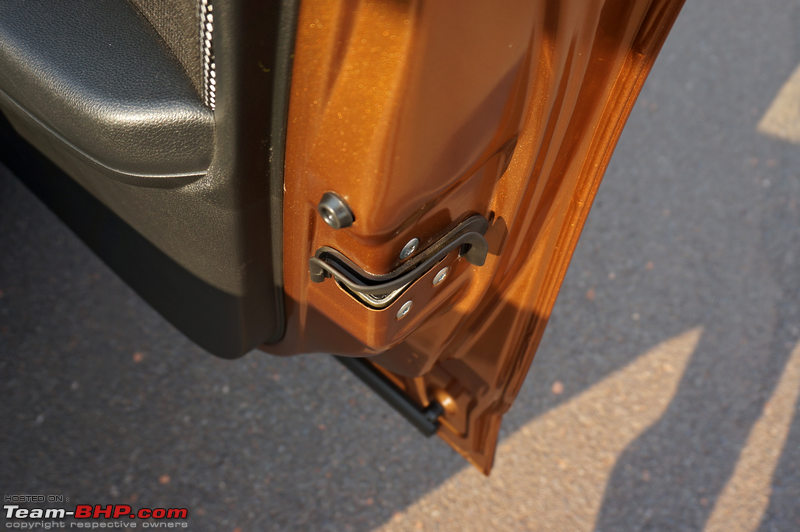 Front seats are very comfortable, while the driver's seat height adjustment has a long range. Unlike the cheap Amaze / Brio slim seats, these are proper full size seats:  Seat height adjustment lever is sturdy:  Fore & aft travel is good enough to allow even drivers with a laid back driving position to be comfortable:  Healthy range for the seat height adjustment. Short or tall, no one will complain. I am 5'10" and with driver's seat at its lowest position, I had about 5 inches of headroom:  A closer look at the black & silver fabric upholstery with double stitching. The fabric is soft and of good quality. Notice the pattern on the side is the same as the one on the fabric insert on the doorpad:  Sturdy metal lever for fore & aft movement:  WR-V gets a much-needed driver armrest with a soft padding on the top. However, its positioning is poor. Should have been placed a little ahead. Additionally, the design is such that the driver's arm keep slipping down on the passenger's side:  None of the variants gets height-adjustable seatbelt. For a car costing as much as the WR-V, this is a glaring omission:  ABC pedals are positioned perfectly. Lame excuse for a dead pedal though. It's just a crude piece of rubber stuck onto the carpet:  Fat A-Pillars create blind spots around corners and ghat sections. The quarter glass provides an airy feel to the cabin though:  Wing mirrors adequately cover the action behind:  On the flip side, visibility through the IRVM is limited due to the thick C-pillars and high windshield. No auto-dimming IRVM, you have to manually flip the switch:  Even while reversing, the rearward view is average. Rear headrests are small, but C-pillars are thick. Thankfully, Honda has provided a reversing camera. Reverse parking sensors would have made things easier:  Center fascia is slightly tilted towards the driver. Don't miss the piano black finish here and the silver inserts around the air-con-vents and gear lever:  Central air-con vents don't get air volume control. The cooling power of the air-con is excellent. Even on a hot summer day, the system chilled the cabin in quick time:  7-inch touchscreen infotainment system is identical to the one in the City facelift. It's functions are covered in a separate post:  Feather-touch climate control looks über cool. Easy to use too. A light tap is all that's required. Different controls are well spaced out, and the system responds with a confirmation beep for each input. Party trick: Swipe to max out / minimise blower and temperature settings. Downside? You need to take your eyes off the road to change any setting. You can switch the fan off only with the on / off button. It can be started with the speed regulator, but cannot be switched off with it. The blower is silent on levels 1 & 2. It gets audible on levels 3 & 4, loud from level 5 onwards. The lowest temperature that the system goes to is 19 degrees centigrade before hitting LO, while the highest temperature it goes to is 31 before hitting HI:  HDMI & USB slots along with 12V power outlet have plastic covers and are located below the climate control system on the center console:  Two cupholders ahead of the gear knob, and a rectangular storage spot that can easily hold a 5.5" smartphone. Build quality is light and the console moves if you shake it with a firm hand:  Center console does not get cupholders like the Jazz because of the armrest:  A couple of cubby holes to the right of the handbrake: 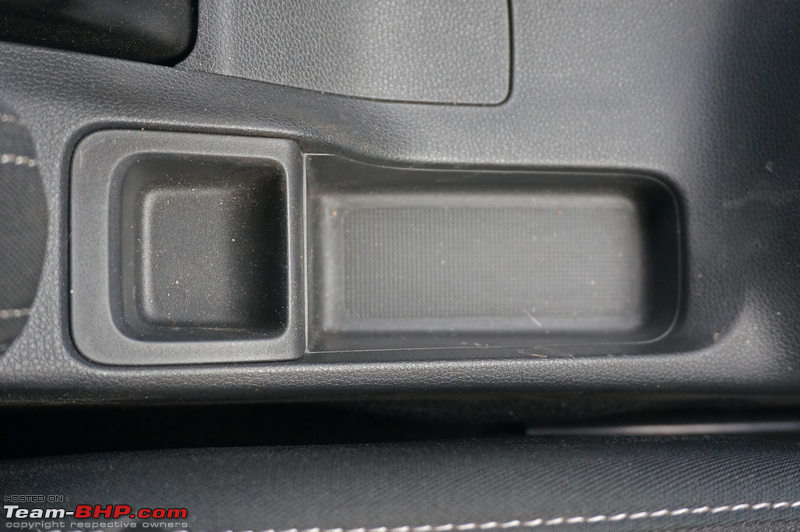 Under the armrest is a deep storage bin with a 12V power outlet and a second USB port. Both have plastic covers:  Dual airbags are standard across all variants:  The glovebox is medium-sized. No ugly USB / iPod / AUX cables dangling loose:  Classy matte silver surround around the side air-con vent:  Sunvisors feel budget-grade. Only the passenger gets a vanity mirror. Older Jazz had one for the driver as well: 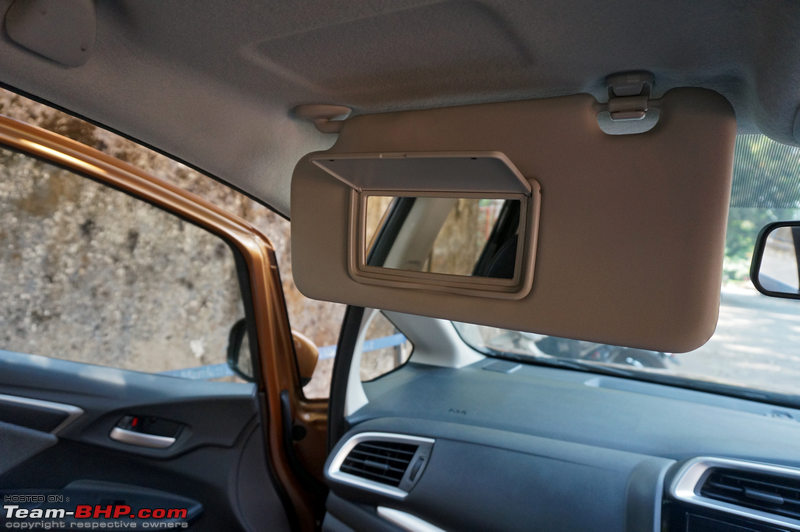 Passenger footwell narrows down at the right. Exposed metal bolts look ungainly: 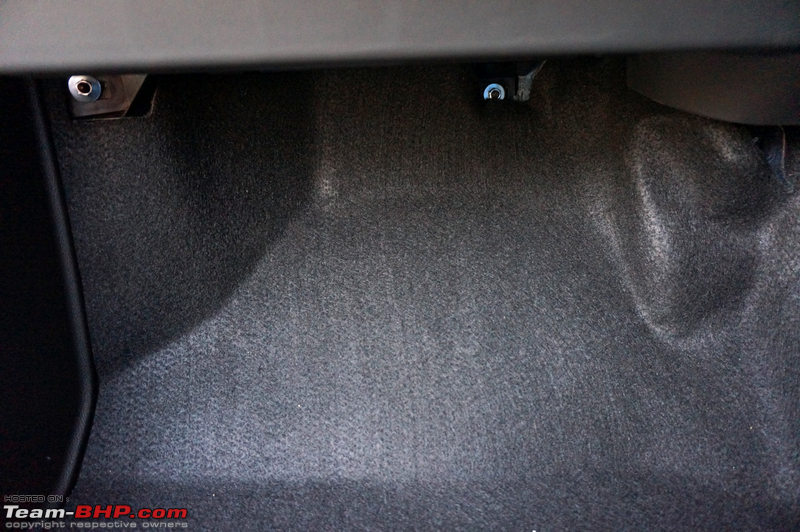 Front roof console has 2 individual map lights with push-to-activate operation as well as buttons to operate the lights and sunroof. Bluetooth mic is neatly placed in between the switches: 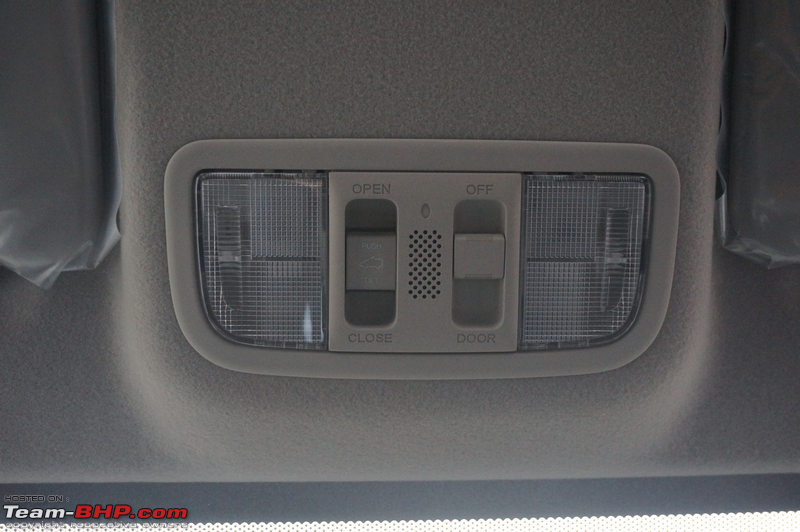 Sunroof cover is manually-operated: 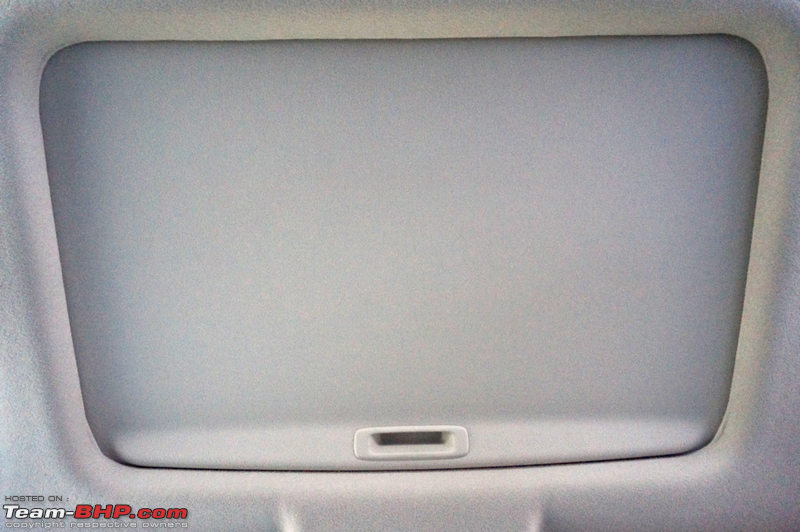 A view out of the sunroof. For the size of the car, the sunroof is decently sized. It has an anti-pinch feature: 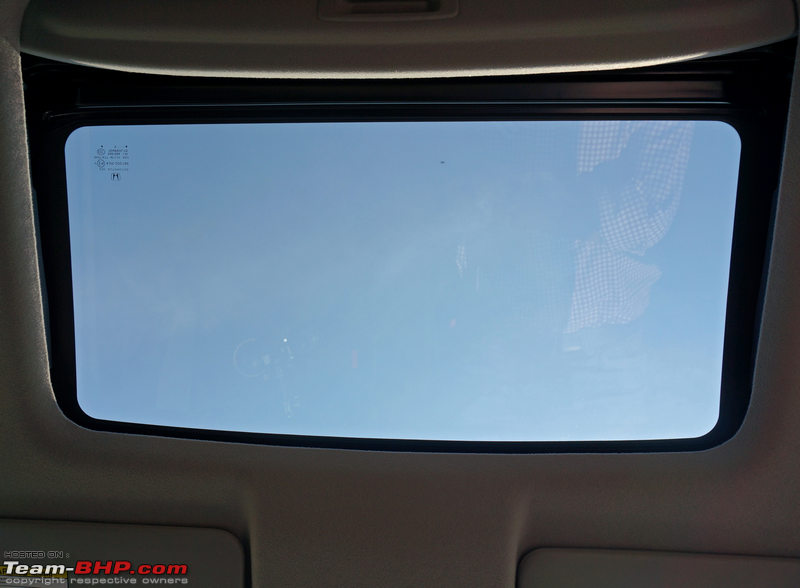 You can pop it up for ventilation by pushing the button upwards: 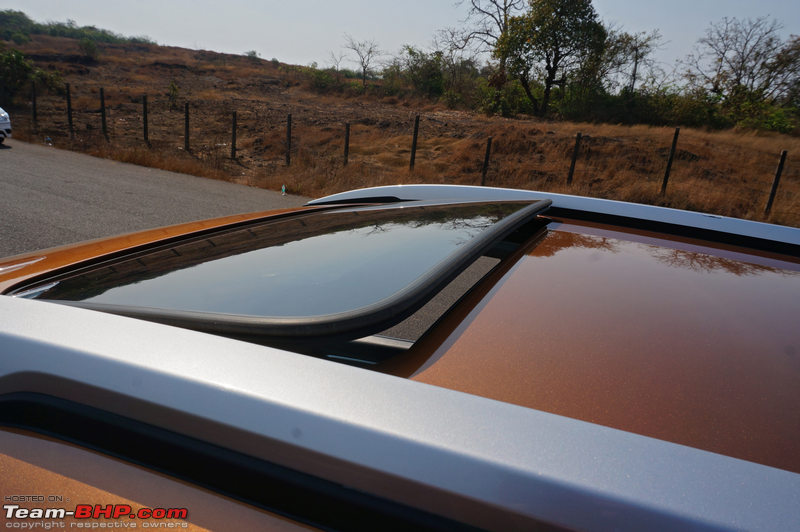 With the sunroof open, a lot of light comes into the cabin. This is the max it opens to: 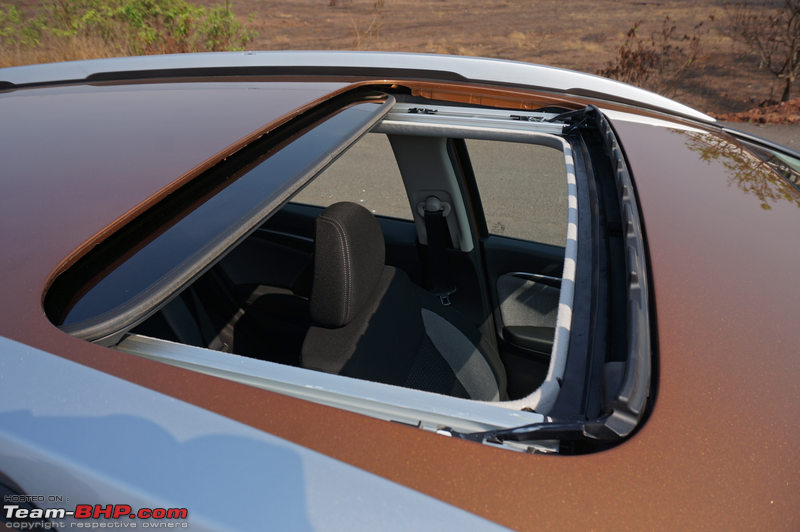 Last edited by Aditya : 1st June 2017 at 15:23. |
| |  (34)
Thanks (34)
Thanks
 |
| The following 34 BHPians Thank Aditya for this useful post: | aabhimanyu04, anshumandun, Avikbrio, avingodb, blackwasp, CarguyNish, carrazy, Dr.AD, GTO, InControl, Karthik Chandra, kutts, libranof1987, myavu, Nohonking, PAkshay, phoenixash, procrj, PuntoMania, RavenAvi, Redline6800, rshanker, S.MJet, samaspire, sarathlal, scopriobharath, SmartCat, sunny29584, swiftnfurious, uday.ere, vb-saan, Vid6639, Vik0728, vikred |
| | #5 |
| Team-BHP Support  | Interior - Rear Like the front, the rear doors open and close in a three stage action. They are lighter than the ones at the front. While getting in, the first thing you'll notice about the WR-V is the large rear doors. Moreover, they open at an angle of nearly 90 degrees. This makes ingress / egress a breeze! The pensioners are going to love this  ! ! Wide gap between the B-pillar and the seat base makes it easier to step in & out:  Door sill is not very wide either, which means occupants do not have to move their feet over the sill when entering or exiting the car:  Like the front, the rear doorpads sport silver and padded fabric inserts. Again, just like the front, there are no soft touch plastics anywhere - not even on the armrests:  Door pocket is large enough to carry a 1-liter bottle and tiny items:  Rear bench is designed to accommodate 3 persons. The seat base and seatback are both largely flat and cushioning is adequate. However, lower back support is average. Fabric upholstery is identical to the front seats. No "magic" seats for the WR-V unlike the Jazz which has them on the top variant:  Legroom is generous and two six-footers can sit behind one another in reasonable comfort:  Cabin width is good, which means three adults can sit quite comfortably but the Middle passenger doesn't get a headrest. There's also no center armrest. The headrests for the left and right passengers are small, fixed and pretty much useless:  Seatbacks of the front seats are scooped out, which help in freeing up some more knee room for the rear seat occupants. Both front seats have seatback pockets which are wide but not deep: 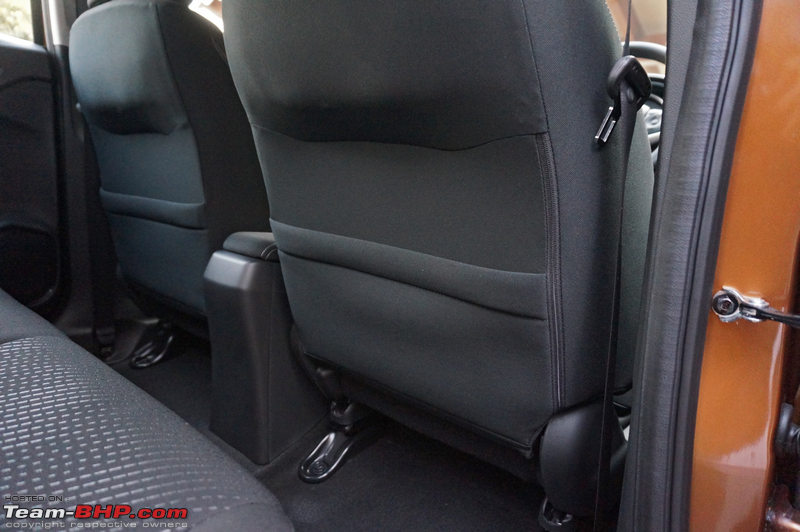 With the front seat in my driving position, I had about 5 inches of knee room. Move the front seat all the way forward and the knee room is enormous. Even with the front seats moved all the way back, I still had ~3 inches of knee room. The seatbacks of the front seats are soft and there is ample space below the seats allowing you to slide your feet under them:  Seat is at a fair height for the average adult. The seatback doesn't recline, but the angle is fairly comfortable. Headroom is good as well. I had ~ 2 inches left when sitting in a fairly upright position. Taller occupants might find the underthigh lacking. As you can see the headrests are useless:  The floor slopes up towards the front seats, as the fuel tank is located below (Jazz also has it under the front passenger's seat):  Overall glass area is generous. There's enough light coming in at the back and even with the black interiors, passengers won't feel claustrophobic:  Rear window doesn't go down all the way:  Useful cabin light placed between the front & rear seats. Strange how some manufacturers miss out on this. All cabin lights go off with a theatre dimming effect when the car is locked unless they are in the "on" position:  All three passenger doors have spring loaded grab handles above them. Only the right rear one has retractable coat hook:  Rear passengers get 3-point seatbelts on either side, and a lap belt for the passenger in the middle. Notice how thick the C-pillar is:  The back of the front centre console is completely bare. No rear air-con vents, not even a cupholder for the rear passengers or a charging port:  Central floor hump is not very prominent but the the middle passenger will prefer to place his feet on either side of it to be comfortable:  Like the Jazz, there is underseat storage space available since there's no fuel tank below. This can be useful for oddities like an umbrella or small shopping bags. However since these aren't "magic" seats you can't fold the seat backs for longer objects:  At 363 liters, boot space is larger than the EcoSport and Brezza. Low & wide opening makes loading luggage a breeze:  There's no large wheel arch eating into the boot like in the EcoSport. It will easily accommodate enough luggage for the weekend family trip:  Unlike the Jazz, the rear parcel tray can be attached to the hatch with strings and moves up when you lift the hatch. It has two deep grooves to park the odd items:  There's about a one inch gap from the parcel tray to the seat back which makes it easy for stuff to fall into the boot, if you're not careful. This gap is also there in the Jazz and EcoSport:  Like the lower variants of the Jazz, you get pull-type stalks made of a cheaper plastic for unlocking the seats: 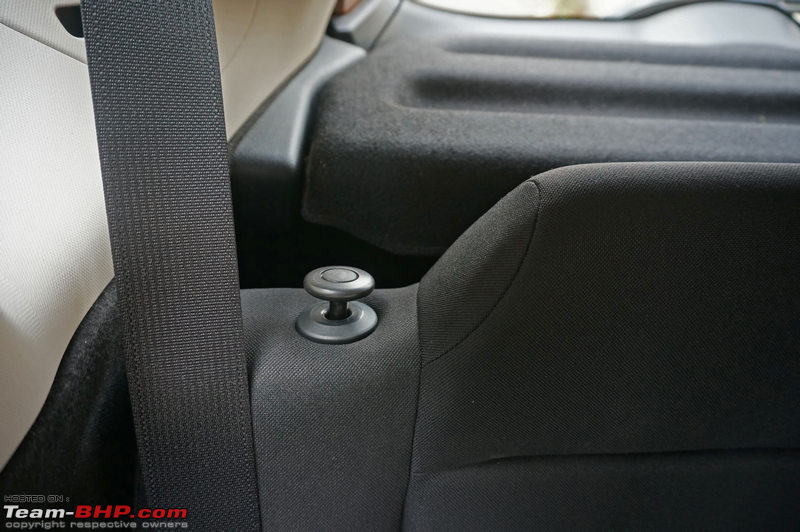 WR-V does not get a 60:40 split folding rear seat - loses out on the flexibility offered by the Vitara Brezza and EcoSport:  Plastic cladding inside the boot lip has dummy vents:  Rear seat doesn't fold down flat. Still, there is a lot of space on offer:  Tailgate gets full plastic cladding on the inside. Thankfully, no cost-cutting here:  Boot lamp? Check:  Thin cord to lift the boot floor:  Tools are neatly placed in the boot in a Styrofoam casing (not loose like in the City):  Spare tyre wraps around a 16" steel wheel (tyre size = 195/60 R16). Surprisingly, while our WR-V rode on Bridgestones, the spare is a Michelin Primacy 3ST:  Last edited by Aditya : 14th September 2017 at 07:16. |
| |  (30)
Thanks (30)
Thanks
 |
| The following 30 BHPians Thank Aditya for this useful post: | aabhimanyu04, akshay81, anshumandun, Avikbrio, CarguyNish, carrazy, deehunk, Dr.AD, dZired, GTO, InControl, Karthik Chandra, libranof1987, Nohonking, palsaumik, phoenixash, procrj, RavenAvi, rshanker, S.MJet, samaspire, scopriobharath, SmartCat, sunny29584, swiftnfurious, uday.ere, vb-saan, Vid6639, vikred, vishy76 |
| | #6 |
| Team-BHP Support  | In-Car Entertainment The VX variant gets a 17.7 cm (7-inch) touchscreen infotainment (AVN) system, called the Digipad. This is the same unit as seen on the recently facelifted City. The system has features like navigation, voice recognition, Bluetooth telephony, audio streaming, 1.5 GB internal memory, 2 USB slots, 2 microSD card slots and 1 HDMI-in slot. It also features Mirror Link support for smart phone connectivity, while Wi-Fi support for Internet is available as an option. The system is capable of providing live traffic information on the go when connected to Wi-Fi. CD / DVD and Aux-in support are missing. Touchscreen is placed fairly high on the dashboard - this means that the driver does not have to look too far down to glance at the screen. Piano-black finish is tasteful, but a fingerprint magnet. Touch sensitivity is good, but the system does have some lag and takes a little time to respond after selecting an action. Visibility even under direct sunlight is good:  In the VX variant, music is played out through 6 speakers (including 2 front tweeters). S variant gets only 4 door speakers without the front tweeters:  Tweeters are located on the top of the dashboard:  The Digipad system is based on an older Android OS interface with a customisable home screen:  The interface is simple and easy to operate. Font size is large as well, making it easy to read on the go:  Sound settings include the usual equalizer settings and fader / balance adjustments. Sound quality is quite good. Even while playing a bass-heavy track at max volume, the speakers didn't start distorting. Clarity is good and overall sound quality is impressive for an OEM system:  Dual microSD card slots - one for media and one for navigation:  Annoying standard disclaimer comes up every time you start the system. One cannot pair a phone or use any features such as internet browsing or check e-mail when the car is on the move:  A close look at the different options on the infotainment system:  Navigation software provided by iGO! Some of the features of the system include 3D landmarks, lane guidance, junction view, free text-based POI search & voice command-based search:  Navigation is good in terms of timing & accuracy. The instructions are spot on and easy to follow. We lost our way once and the system got us home without any fuss:  Touchscreen doubles up as a display for the reversing camera. You get three viewing modes (top, normal or wide). Guidelines are fixed. Slot the gear in reverse and the infotainment screen switches to the display for the reverse camera. The music being played is also muted automatically:  Last edited by Aditya : 1st June 2017 at 15:25. |
| |  (22)
Thanks (22)
Thanks
 |
| The following 22 BHPians Thank Aditya for this useful post: | anshumandun, Avikbrio, CarguyNish, Dr.AD, dZired, GTO, InControl, Karthik Chandra, Nohonking, palsaumik, phoenixash, Puffdamgcdragon, RavenAvi, Redline6800, rshanker, S.MJet, scopriobharath, sunny29584, swiftnfurious, uday.ere, vb-saan, Vid6639 |
| | #7 |
| Team-BHP Support  | Driving the 1.5L Diesel MT 1.5L i-DTEC motor sure is a tight fit in the WR-V's compact engine bay:  The 1.5L, 4-pot diesel engine mated to the 6-speed manual gearbox is shared with the City and the Jazz. Good thing that Honda decided on the 6-speed and not the 5-speed tranny from the Amaze & Mobilio. The diesel makes 99 BHP @ 3,600 rpm and 200 Nm of torque @ 1,750 rpm. The WR-V diesel weighs in at 1,176 kg, resulting in a power to weight ratio of 84 BHP / ton which is better than it’s rivals such as the Vitara Brezza (76 BHP / ton) and EcoSport (79 BHP / ton). While its torque to weight ratio of 170 Nm / ton is better than the EcoSport’s 164 Nm / ton, it is narrowly beaten by the Brezza’s 171 Nm / ton. Full technical details are available in this post. Depress the clutch and hit the start/stop button to crank the engine. You are greeted by a clatter that is now synonymous with this 1.5L i-DTEC Earth dreams engine. There is no mistaking it for anything else. In fact, the i-DTEC is loud even by diesel car standards. On startup, vibrations are felt on the pedals and gear lever. Driveability is where this engine shines. The motor is responsive from idle rpms itself with no turbo lag to speak off. Torque and power delivery are so linear that you feel at home right away, even if you've been driving naturally aspirated 4-cylinder petrol engined cars. The gradual power and torque delivery, coupled with evenly spaced gear ratios, makes the WR-V immensely tractable to drive. The engine can easily pull from low rpms. In fact, it can take off from standstill in 2nd gear without any throttle input. The engine is alive even at low rpms, as long as you keep the revvs above 1,000 rpm. While the WR-V will comfortably potter around at 50 km/h in 4th gear with the engine ticking over at 1,400 rpm, the powerplant starts coming alive from 1,500 rpm and really picks up pace after 2,000 rpm. Light throttle inputs are all you need to potter about in town. Since there is no turbo 'kick' that comes in when the turbo spools up, it's very easy to drive within city limits. Throttle response is sharp even when you step on the gas in higher gears due to the lack of turbo lag. The engine tune is extremely practical for the urban commute thanks to the fewer gearshifts needed. The power train delivers decent performance as well. Straight line acceleration is brisk. There is more than enough torque to get you going, and enough power to sustain it. Overtaking is fuss-free; thanks again to the lack of turbo lag. The tune really focuses on the low to mid rpm range than top end whack. Open road performance is competent, but the WR-V's engine isn't as exciting as the EcoSport's 1.5L diesel (99 BHP / 205 Nm). The Ford remains the choice of enthusiasts. The i-DTEC engine isn't high-rpm friendly. It redlines at a very conservative ~4,400 rpm, but it’s best to keep it below 4,000 rpm even during spirited driving. The engine doesn't sound or feel happy near the 4.400 rpm redline. You can also feel the power tapering off once the revvs cross 4,000 rpm. Revv hard and the WR-V will hit a maximum speed of 39 km/h in 1st, 70 km/h in 2nd and 110 km/h in 3rd gear. It's best to work the torque and shift up earlier than maxing out in each gear. The WR-V diesel can cruise at triple digit speeds all day long. Unlike the Amaze, the engine isn't electronically limited to 140 kph. You'll easily maintain pace with fast traffic on the right lane of the expressway. Thanks to the 6th cog, the WR-V is a relaxed cruiser over long distance trips on the highways. (related thread). The car can waft on the expressway at 100 km/h with the engine turning around at a leisurely 1,900 rpm, while 120 km/h is seen at 2,300 rpm. The WR-V diesel is also equipped with cruise control, which can be engaged over 40 km/h. Climbing up steep inclines & ghat sections is an effortless exercise too. The WR-V diesel has an ARAI rating of 25.5 km/l, which is 1.8 km/l lower than the Jazz. Still, the i-DTEC delivers high fuel economy than its rivals and will keep its owners happy in this area. The small, short throw 6-speed gearbox is nice to use. The shift action is smooth and we did not have any trouble engaging the intended gear. The clutch isn't too light nor too heavy. It's par for the course. Honda claims that the gearing has been set to improve uphill climbing ability and smooth acceleration. The final gear has been set to a high ratio to enhance fuel economy. An area where the WR-V disappoints is NVH. The insulation levels are similar to the City and not the Amaze. The engine is very audible inside the cabin, even at an urban revv range of 1,800 - 2,000 rpm. What makes it worse is the crude, unpleasant engine note. On the move, the diesel motor always makes its presence felt. Listen carefully and you will be able to hear the turbo whistle when the revvs cross 2,200 rpm. As the speedometer climbs over 100 km/h, wind noise starts creeping into the cabin as well. Another major disadvantage of the WR-V diesel is the significant amount of engine & drivetrain movement felt on the pedals. Vibrations are felt not only on the clutch, but even on the accelerator. It's directly proportional to engine rpm. The experience takes away from the refinement you expect from a Honda. Additionally, there are vibrations felt on the gear lever as well. Passengers won't be complaining as they won't feel it, it's only felt on the driver controls like gears and pedals. What passengers will hear is the diesel drone from this engine. This has been a problem with this engine ever since it's introduction in the Amaze. Honda has tried hard to reduce the noise since then with the Jazz, updated City and the WR-V but it's still far from acceptable. 1.5L diesel with Earth Dreams technology develops 99 BHP & 200 Nm of torque:  Both, the diesel & petrol have an insulation sheet under the bonnet. The diesel surely needs it!  6-speed gear knob for the diesel is all new vs the ones on City and Jazz. Finished in glossy black, it’s small & great looking, but could have been meatier:  Gear lever is not leather-wrapped, but it does get a leather boot:  Vertically mounted intercooler sits next to the radiator:  Notice how the lights on either side of the speedometer have changed to green in this picture. If you drive with a light foot, it switches from blue to green, indicating an economical driving style. Cruise control indicator denotes that the function is engaged:  Fuse box sits to the extreme left of the car in the engine bay:  Fuse removal tool neatly placed inside the fuse box cover:  Last edited by Aditya : 1st June 2017 at 15:25. |
| |  (29)
Thanks (29)
Thanks
 |
| The following 29 BHPians Thank Aditya for this useful post: | abhinav.s, akshay81, anshumandun, Avikbrio, CarguyNish, GTO, InControl, Karthik Chandra, libranof1987, myavu, Nohonking, palsaumik, phoenixash, procrj, Puffdamgcdragon, RavenAvi, Researcher, Revy, rshanker, S.MJet, Samba, scopriobharath, SmartCat, sunny29584, swiftnfurious, uday.ere, vb-saan, Vid6639, vikred |
| | #8 |
| Team-BHP Support  | Driving the 1.2L Petrol MT Familiar 1.2L i-VTEC motor:  This 1.2L, 4-cylinder i-VTEC mill is the same one that does duty in the Jazz (and currently powers the Brio & Amaze). The engine produces 89 BHP @ 6,000 rpm and 110 Nm of torque @ 4,800 rpm. These figures are identical to those of the Jazz. The WR-V’s power to weight ratio of 82 BHP / ton and torque to weight ratio of 101 Nm / ton is significantly lower than the EcoSport’s Ecoboost 1.0L with 98 BHP / ton & 135 Nm / ton (92 BHP / ton & 117 Nm / ton for the 1.5L). Honda could've easily offered the City's fantastic 1.5L i-VTEC engine in the WR-V (the Jazz is already being exported with the same). The WR-V begs for a bigger engine and considering Ford has a 1.5L Petrol, Honda should have pitted the WR-V against it with the 1.5L i-VTEC. This is seriously a missed opportunity for Honda for what is a very important car for them. The 1.5L is a perfect match for the WR-V and it's image as a SUV. On the other hand it looks like Honda decided to play safe. Marketing considerations & lower excise duties probably forced Honda to stick with the smaller 1.2L powertrain. Well, we can only hope that the 1.5L is offered in the future, at least in a limited 'performance' edition. Unlike the diesel, the WR-V petrol strangely misses out on an engine start/stop button. You have to crank the engine with the turn of a key. There is no need to press the clutch or have your foot on the brake to fire up the engine. Start the WR-V petrol and the experience is the opposite of the diesel. The motor is super silent, staying that way at low revvs. Even in performance & driving characteristics, the petrol & diesel motors are diametric opposites of each other. Where the i-DTEC offers superb driveability, the 1.2L suffers from a weak bottom end. It feels distinctly lethargic. That's probably down to the tall gearing, the WR-V's heftier kerb weight & economy-focused tuning. Torque at low rpms is poor and the throttle feels very dull in certain situations. You have to seriously flog the motor if you want to zip through traffic. But then giving it the stick doesn't help fuel economy! Where the diesel could be driven like an automatic around town, the 1.2L petrol requires frequent downshifts in the urban commute. While it can move about at 40 km/h in 4th gear with the engine turning over at 1,500 rpm, if gaps are needed to be closed quickly, a downshift or two is a must. Remember how Civic owners unanimously complained about driveability in the city? You'll hear WR-V owners singing a similar tune. Climb up the revvs and you'll experience a mid-range that is acceptable (above 3,000 rpm). Here's where the engine note becomes audible but it's a likeable sound for enthusiasts. A non enthusiast will probably not even go past this. Like all Honda petrol motors, the WR-V is revv happy and climbs up to it's 6,750 rpm eagerly. That's a good thing because you'll need to use those revvs to access the 1.2L mill's performance. The motor is alive and kicking past 4,000 rpm. Revv it hard with perfectly timed gearshifts and you'll get respectable 0-100 figures. But you have to make the engine work hard. It's not an underpowered unit, but the power delivery is just out of reach for regular use. Overall, the performance simply isn't as effortless as the EcoSport’s petrol engines. The lack of power at low rpm's also poses a problem on inclines. You cannot shift up when climbing a ghat unless you are wringing the motor. If you do shift up, you will fall out of the power band every time you lose even a little speed. This can get very annoying. Highway capability is satisfactory (not outstanding). The WR-V will keep up with fast traffic in the right lane. When you want to overtake, you'll have to downshift...no two sides to that. On a single lane highway, we had to wring the engine in 2nd or 3rd gear every time we wanted to overtake. The WR-V can touch maximum speeds of 45 km/h and 82 km/h in 1st and 2nd gears respectively. The car can cruise in 5th gear at speeds of 100 km/h and 120 km/h with the engine revving at 3,250 rpm and 3,900 rpm respectively. The petrol loses out on the the cruise control feature from the diesel. Unlike the diesel, the WR-V petrol gets a 5-speed manual gearbox. Honda claims this is a newly developed transmission to maximize the performance of the car. The final gear has been set at a low ratio to improve acceleration performance. In terms of fuel economy, the petrol carries an ARAI rating of 17.5 km/l. End of the day, you'll wish that Honda had provided the 1.5L petrol on the WR-V. The 1.2L unit's behaviour just isn't exciting enough and will leave one wanting for more. The gearshift action is light & slick. The gates are narrow, as is usually the case with Honda's gearboxes. The clutch is light enough. It's a good thing that the clutch and gearbox are a joy to use since you need to use them a lot to extract the best out of the motor. 1.2L, 4-cylinder i-VTEC mill produces 89 BHP & 110 Nm of torque - exactly the same as the Jazz:  Firewall gets a thin sheet of insulation:  Compared to the diesel, there's more empty space in the engine bay. The WR-V begs for the 1.5L i-VTEC from the City. Come on Honda!  The petrol engine gets no underbody protection. You can see the ground clearly.  Oil sump is dangerously exposed in the petrol. An easy target on bad roads. One large stone and you're in for trouble:  Petrol variant gets a 5-speed manual:  i-VTEC badge on the tail-gate:  Last edited by Aditya : 1st June 2017 at 15:26. |
| |  (32)
Thanks (32)
Thanks
 |
| The following 32 BHPians Thank Aditya for this useful post: | akshay81, anshumandun, Avikbrio, blackwasp, CarguyNish, Dennis, Dr.AD, GTO, InControl, Karthik Chandra, Keynote, libranof1987, myavu, Nohonking, palsaumik, phoenixash, procrj, Puffdamgcdragon, RavenAvi, Redline6800, Revy, rshanker, S.MJet, scopriobharath, Scorpion 10, SmartCat, sunny29584, swiftnfurious, uday.ere, vb-saan, Vid6639, vikred |
| | #9 |
| Team-BHP Support  | Ride & Handling The WR-V sports a McPherson strut suspension at the front and a twisted torsion beam setup at the rear. The car rides comfortably on Indian roads. You don't hear the annoying 'thuds' over potholes. It is compliant over bad roads and undulations too, transmitting very little back into the cabin. While the ground clearance of 188 mm is not as good as the competition, the car can tackle tall speed-breakers without any problem. We didn't get a chance to test the ground clearance with a full load of passengers & luggage onboard so we'll leave the final verdict to our ownership reports. Ride quality at higher speeds is competent as well. It manages to absorb most irregularities and glides over the rough stuff without getting ruffled. The WR-V feels stable at 120 kph and isn't nervous on the highway. That said, it's nowhere as rock solid as a Ford. The handling is neutral for the most part. The car is taller than the Jazz and so body roll is more pronounced but it is well controlled and grip levels are acceptable for most drivers. It's no corner carving machine though. The suspension's behaviour is safe & predicable, but it's not a car whose dynamics will leave a grin on your face. The press cars wore 195/60 R16 Bridgestone Ecopia rubber, which are designed more towards mileage than grip. While these tyres are satisfactory for most drivers, enthusiasts will definitely want to upgrade to wider and stickier rubber. The steering of the WR-V is very light at city speeds, direct and fuss-free. Sure, it's no hydraulic unit, but it's a decent EPS that has been calibrated well. It weighs up as the speedometer climbs and offers enough feel at high speed. The WR-V has a turning radius of 5.3 meters. That's as good or bad as the EcoSport's but marginally wider than the Vitara Brezza's 5.2 meters. Some sub-4 meter sedans have much smaller turning circles, so do not expect the car to be as chuckable in the city. The WR-V has the standard front disc & rear drum braking hardware. The brakes perform as expected. The car stops in a straight line sans drama when braking from high speeds. You'll just take some time getting used to their over-servoed feel & sharp bite especially at slow speeds. ABS & EBD are available as a part of standard equipment across all variants. Last edited by Aditya : 1st June 2017 at 15:26. |
| |  (29)
Thanks (29)
Thanks
 |
| The following 29 BHPians Thank Aditya for this useful post: | abhinav.s, akshay81, anshumandun, Avikbrio, blackwasp, CarguyNish, deehunk, Dennis, Dr.AD, GTO, Karthik Chandra, Keynote, libranof1987, mustang_shelby, nmenon, Nohonking, palsaumik, phoenixash, Puffdamgcdragon, RavenAvi, Redline6800, Revy, S.MJet, Simhi, sunny29584, swiftnfurious, uday.ere, vb-saan, Vid6639 |
| | #10 |
| Team-BHP Support  | Other Points • This review has been jointly compiled with dZired. Thanks to him for the expert observations! • Honda had internally codenamed the WR-V project as the 2FM. • WR-V was first spotted testing in Brazil in March 2016. • Honda revealed the official sketch of the car in October 2016. • The WR-V made its public debut at the Sao Paulo Motor Show in November 2016. • Team-BHP brought you scoop pics of the WR-V when its production began at Tapukara. • India is the first country in the world where the WR-V has been launched. • Fuel tank capacity = 40 liters. • ARAI ratings: Petrol - 17.5 km/l ; Diesel - 25.5 km/l. • Available in two variants only - S & VX. EDIT on 13th March 2018: There is now an Edge variant positioned in between the S and VX trims. • S variant gets black & blue upholstery. • Fuel tank is positioned below the front seats. Helps packaging. • Lane change indicators blink thrice on a light tap of the indicator stalk. • Indicators blink 3 times on locking and 1 time on unlocking the car. Doors auto lock after 30 seconds of the key being outside the car. • Until you open the doors, the power windows can be operated for some time after you remove the key from the ignition. A practical feature that allows you to roll up any window that might have been left open. • Comes with a standard warranty of 3 years / unlimited kms. Extended warranty for 2 more years can be purchased. • ABS + EBD and dual airbags are standard on all variants. • Available in 6 colours - Premium Amber Metallic (new shade), Carnelian Red Pearl, While Orchid Pearl, Modern Steel Metallic, Alabaster Silver Metallic and, Golden Brown Metallic. • Big shoutout to Rahul Bist for sharing this information - thank you! First service at 1,000 km, second service at 5,000 km, third service at 10,000 km. Then, service intervals of 10,000 km / 12 months. Finally common sense prevailed at Honda! • Disclaimer : Honda invited Team-BHP for the WR-V test-drive. They covered all the travel expenses for this driving event. Last edited by GTO : 13th March 2018 at 08:22. Reason: As per reported post |
| |  (35)
Thanks (35)
Thanks
 |
| The following 35 BHPians Thank Aditya for this useful post: | Aficionados, anshumandun, Avikbrio, blackwasp, CarguyNish, Dennis, feluda86, GTO, InControl, Karthik Chandra, Keynote, knightrider_7, libranof1987, mallumowgli, myavu, nmenon, Nohonking, Omkar, palsaumik, phoenixash, PraNeel, Puffdamgcdragon, RavenAvi, Redline6800, rshanker, S.MJet, samaspire, scopriobharath, SmartCat, sudeepg, swiftnfurious, uday.ere, unni246, Varun_HexaGuy, Vid6639 |
| | #11 |
| Team-BHP Support  | The Smaller yet Significant Things Apart from the Premium Amber colour of our test car, the WR-V is available in 5 other shades. This is the Modern Steel Metallic shade:  …Carnelian Red Pearl…  …and Alabaster Silver Metallic. The other colours available are White Orchid Pearl & Golden Brown Metallic:  A "Diesel " sticker on the fuel flap and a couple of markings on the cap to warn the pump attendant what to fill. There are no markings on the fuel cap of the petrol WR-V. Unlike the Jazz, the flap is painted on the inside as well:  A black plastic spill protector is provided:  Recommended tyre pressure for the diesel WR-V is 35 and 32 psi, which is a little on the higher side especially for the front. The lighter petrol version has 32 and 30 psi as its recommended tyre pressure :  VIN & engine number plate is riveted on the passenger side B-pillar:  Cables from the tail-gate are neatly concealed inside a black casing tube:  Dual horns are located low in the engine bay behind the lower part of the bumper. I found the tone rather shrill and after a while, irritating:  You don't need to take the black & chrome smartkey out of your pocket, thanks to the passive keyless entry and go system. Only on the diesel top end VX variant though. The smartkey is identical to the one that comes with the BR-V and feels nice to hold:  No smart key for the Petrol. You get the old-fashioned key to crank the motor. The keyring isn't even illuminated:  Key is identical to the Jazz's:  Height-adjustable steering gets a thin rubber shroud. It hides the ugly bits when the steering is set at a lower position:  A look at the steering wheel of the WR-V petrol. Notice the missing cruise control buttons on the right spoke:  No automatic dimming for the IRVM. Standard day / night manual flick switch is provided - the kind you get in economy hatchbacks:  Climate control’s solar sensor located on the dashboard: 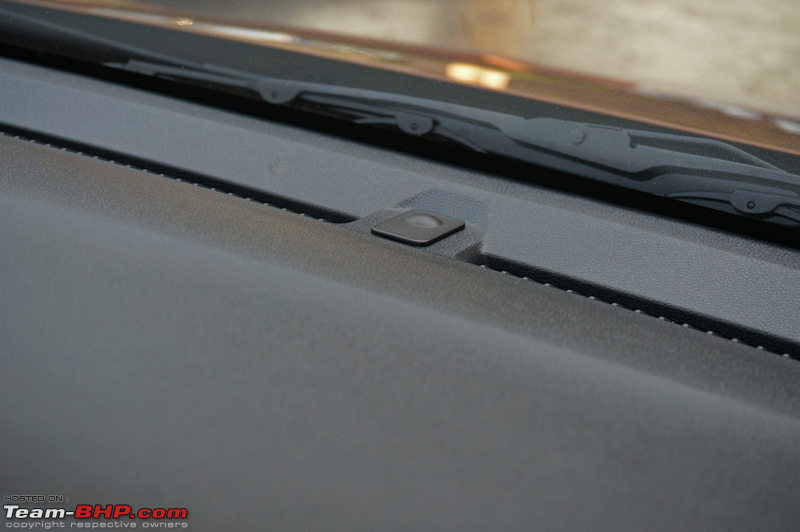 Twist & turn locks to hold the floor mats in place. They're only there on the driver's side:  Things are universally organised, even in places you wouldn't normally look. This is the front passenger footwell. No loose wires dangling about:  One of the areas where fit could have been better. The gap between the glovebox lid and dashboard is quite big:  B-pillar plastic cover has a concave surface as if it's scooped out so your elbows don't hit it:  Soft lining on the insides of the seatback pockets:  As mentioned earlier, the rear parcel tray is attached to the boot lid with strings and moves up when you lift the hatch. Fitting the strings back on the hooks after removal can be fiddly due to the narrow openings in the hooks. Doesn't look like it will pass the test of time either:  Last edited by Aditya : 1st June 2017 at 15:28. |
| |  (39)
Thanks (39)
Thanks
 |
| The following 39 BHPians Thank Aditya for this useful post: | abhinav.s, akshay81, anshumandun, Avikbrio, avingodb, BlackPearl, blackwasp, CarguyNish, catchjyoti, Fraz33r, GTO, InControl, Keynote, knightrider_7, libranof1987, mustang_shelby, myavu, Nohonking, OrangeCar, palsaumik, phoenixash, PraNeel, Puffdamgcdragon, RavenAvi, rshanker, S.MJet, scopriobharath, Simhi, SmartCat, snaseer, sudeepg, sunny29584, supertinu, swiftnfurious, Thad E Ginathom, uday.ere, vb-saan, Vid6639, zavegur |
| |
| | #12 |
| Team-BHP Support  | Re: Honda WR-V : Official Review Thread moved from the Assembly Line to Official Reviews. |
| |  (3)
Thanks (3)
Thanks
 |
| The following 3 BHPians Thank Aditya for this useful post: | GTO, Sisu, uday.ere |
| | #13 |
| BANNED | Re: Honda WR-V : Official Review Fantastic review as always! The WRV is proving quite popular in my college, even the petrol! And the reason is simple it looks great, priced okay, good features and the fact that Brezza has such a long waiting period.  The reliability of Honda helps too and if they could have just added the CVT(with the 1.5 petrol) it would have been a great city car and totally gone head to head with the EcoSport AT. There are some rumours that it is coming. Would just like to add that some WRVs are coming shod with Michelin Primacy 3ST as factory fit, a great thing to see and a much better option than the Ecopias Last edited by agambhandari : 1st June 2017 at 16:16. |
| |  (8)
Thanks (8)
Thanks
 |
| The following 8 BHPians Thank agambhandari for this useful post: | Aditya, bhavik.1991, GTO, mallumowgli, Nithesh_M, Nohonking, sri_tesla, vnabhi |
| | #14 |
| BHPian Join Date: Mar 2012 Location: NEW DELHI
Posts: 147
Thanked: 218 Times
| Re: Honda WR-V : Official Review Great review Aditya! Quality of Team-Bhp official reviews are fantastic. I don't think any points are left to imagination and all small bits are covered. With that being said, this is one ugly car (from my perspective). Honda could have designed it so much better. I miss the civic days when Honda was on top of their game on the design front. I personally would buy the Jazz if I was in the market for a compact runabout and save a couple of lacs instead of going with this ugly duckling. Lets hope the look grows on me with time. Cheers! |
| |  (8)
Thanks (8)
Thanks
 |
| The following 8 BHPians Thank Sisu for this useful post: | Aditya, bhavik.1991, CrAzY dRiVeR, GTO, PrasannaDhana, rednikhil, Skyline_GT, Waspune |
| | #15 |
| BHPian Join Date: Mar 2016 Location: Faridabad
Posts: 126
Thanked: 31 Times
| Re: Honda WR-V : Official Review Finally the review is out. Good review. This review covers everything what an enthusiast or a layman needs to know and then some great attention to detail. Any idea of CVT being released? |
| |  (3)
Thanks (3)
Thanks
 |
| The following 3 BHPians Thank SpoiledBratt for this useful post: | Aditya, bhphog, GTO |
 |

